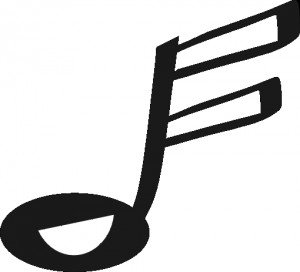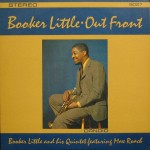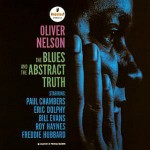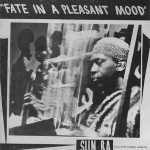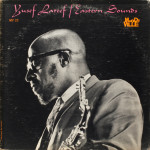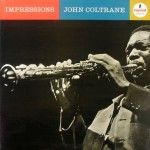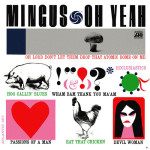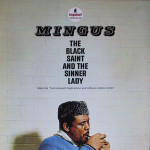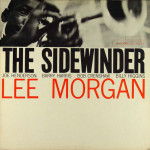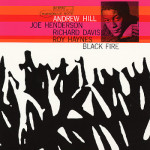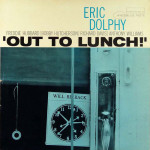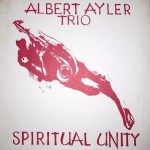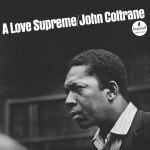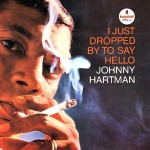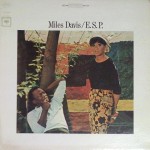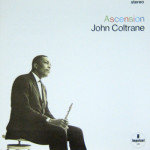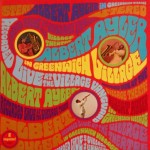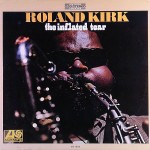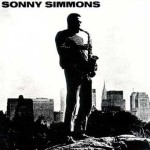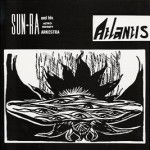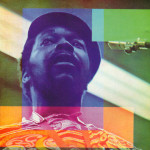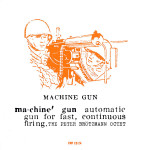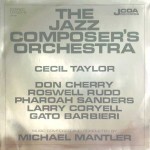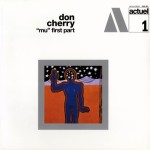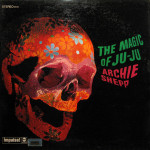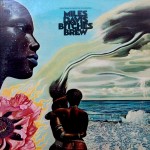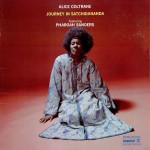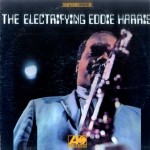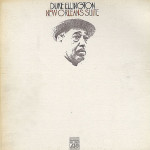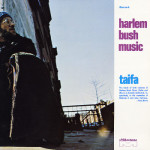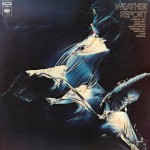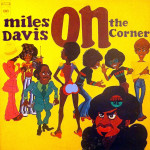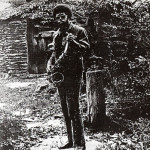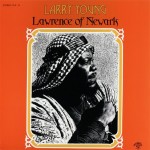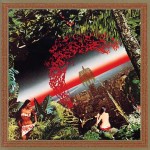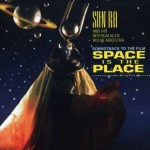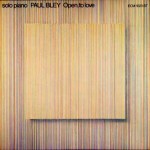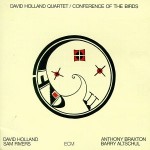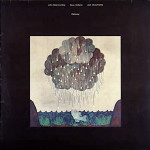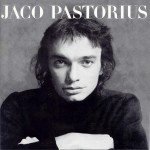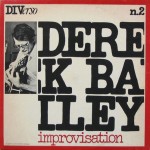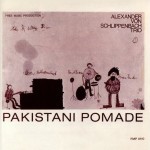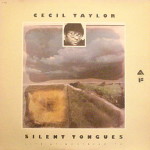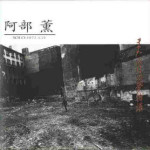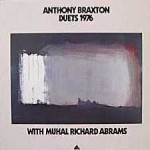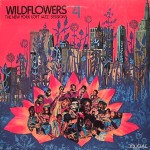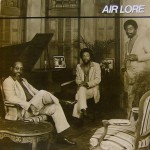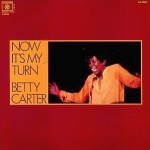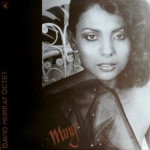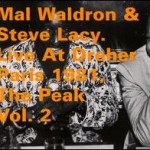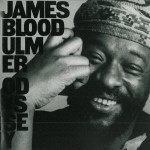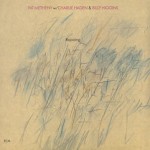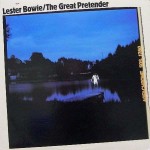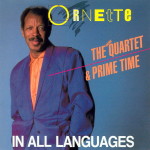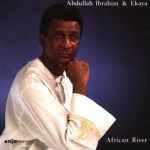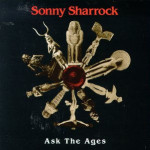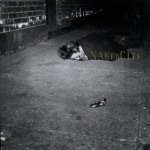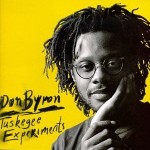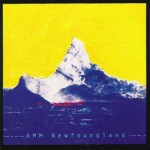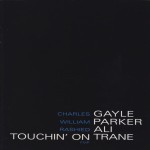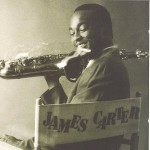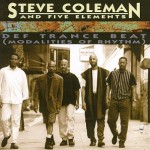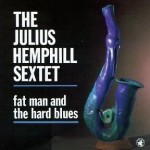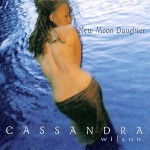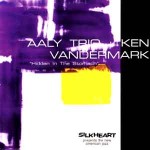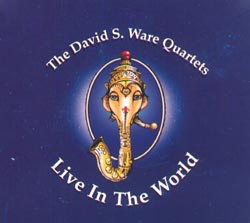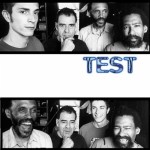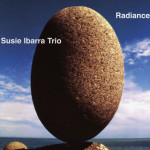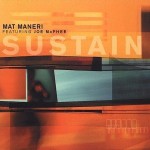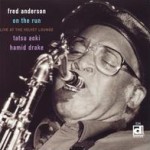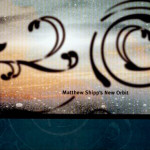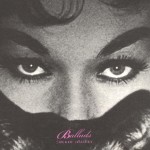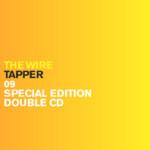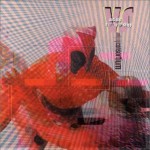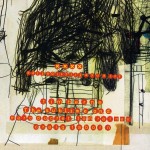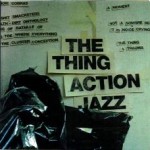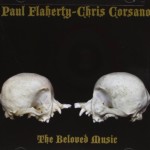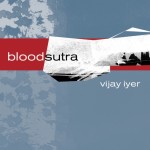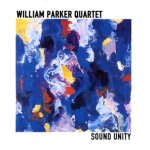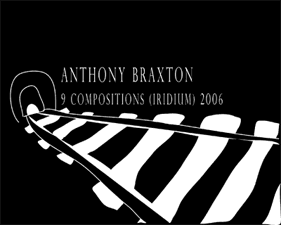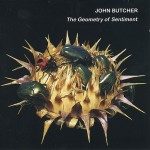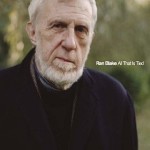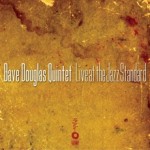Welcome to a “virtual” compilation album of jazz from 1960 to 2009, intended to be an introduction to jazz music from that time period for anyone with an interest. It is generally meant to be a follow-up to a compilation like The Smithsonian Collection of Classic Jazz, with a focus on a later time period. In moving into more modern periods of jazz history, the listening experience can be more challenging for many because there begin to be marked departures from familiar modes of musical practice. With regard to literary practice, the Russian Formalist Viktor Shklovskii wrote of “laying bare the device” and the technique of “defamiliarization” (or “estrangement”), which are key elements underlying most modernist art movements that, as a general rule of thumb, all rely on a fairly high degree of audience sophistication. The same holds for modern jazz. The music here does get quite challenging at times, and is more along the lines of serious, intensive listening music than casual background or dance music. That is as much a reflection of trends in music history as a reflection of choices among the trove of great recordings that could easily replace the selections here. Every effort has been made to take that into consideration in keeping the overall set as accessible as possible for relatively novice listeners, but without shying away from important recordings that make for challenging listening. All that said, listening to this compilation should probably be prefaced with some understanding of the roots of jazz prior to 1960. The criteria in making selections has been to attempt a reasonable sketch of the musical innovations of modern jazz, with attention also paid to historical trends in the sense of well-known sub-genres. Songs — and some artists — already represented on other compilations like The Smithsonian Collection, have been excluded here to avoid redundancy. It is important to note that this compilation does not track only popular, heavily marketed trends in a rote manner, and so anyone who believes the mainstream account that “jazz just died” at some time in the 1970s should probably look elsewhere for a more sanitized overview that pretends jazz hasn’t kept on surviving at a smaller scale via independent, underground, and publicly-subsidized outlets.
This collection is arranged roughly in chronological order by recording date, though it is not strictly chronologically arranged. For each song selection, the songwriting credits, first release, recording date/location, and personnel are listed to the greatest extent possible, though precise information is not available in every case. Compiler’s notes are given for each selection as a guide for those seeking clues as to suggested musical elements to listen for, as well as to provide reasons for the inclusion of certain tracks. This collection is not comprehensive and exhaustive, of course, and so it does make some omissions of many great and worthy artists and recordings. Moreover, numerous popular movements like “smooth jazz” and “acid jazz” are not represented, as some argue those are not properly called “jazz” at all, at least in the sense that their audiences tend to be outside those historically associated with jazz as such. In order to allow a greater number of different recordings to be represented, while still allowing the collected material to hypothetically fit on a reasonable number of compact discs, many selections are presented in edited form. While those selections deserve to be heard in their complete form, the difficult decision to present edited version seemed necessary given the length of most modern jazz recordings. In earlier eras jazz musicians were limited by recording formats that only offered a few minutes worth of recording time. With technological advances, recordings could be made of indefinite duration. Many musicians have taken advantage of that fact. With the advent of digital music, listeners programming this collection electronically can perhaps ignore the suggested time edits, which are merely a byproduct of the limitations of physical media.
Anyway, the primary objective of this collection is to serve as an educational tool to introduce new listeners to modern jazz. It is hoped this will be a a launching pad for the exploration of the wide and varied interstellar universe of modern jazz. It is hoped that listeners will follow up a careful review of this collection with explorations of other jazz music. The personnel lists, record label listings and compiler’s notes hopefully provide some suggestions for additional listening. But don’t stop there. For more introductory jazz resources, see Jazz Resource Guide.
Disc 1
 1. Booker Little – “A New Day” (Booker Little) (5:30) from Out Front (Candid CJS 9027) (1961)
1. Booker Little – “A New Day” (Booker Little) (5:30) from Out Front (Candid CJS 9027) (1961)
Recorded March 17 or April 4, 1961 at Nola Penthouse Studios, New York, NY, USA.
Personnel:
Booker Little – trumpet
Eric Dolphy – flute
Julian Priester – trombone
Max Roach – drums
Art Davis – bass
Don Friedman – piano
Notes:
Memphis-born Booker Little appeared poised to emerge as a dominant voice on the trumpet. Tragically, Little passed away young at the age of 23, without ever gaining much widespread recognition. He had played in bands lead by Max Roach and others, but also had a few opportunities to lead his own groups on a number of recordings. “A New Day” from Out Front is firmly rooted in the hard bop traditions of the later 1950s, but shows an adventurous compositional and improvisational style that showcases unusual harmonies, with liberal use of dissonances (exhibited to greater effect on other Little songs from the same album like “We Speak”). Of note here is a lyrical drum solo from Roach, who had taken Kenny Clarke’s place as one of the foremost be-bop drummers. Roach had continued to develop thorough the years, such that on this 1961 recording there are traces of a be-bop style with some riding of the cymbal, but even more pronounced were the effortless polyrhythms (that is, multiple rhythmic patterns played simultaneously) and dramatic lyrical effects created from switches between drums of different pitches (that is, those of higher and lower sounds). Also, the great Julian Priester contributes deftly understated accompaniment and a solo on trombone.
 2. Oliver Nelson – “Yearnin'” (Oliver Nelson) (6:23) from The Blues and the Abstract Truth (Impulse! AS-5) (1961)
2. Oliver Nelson – “Yearnin'” (Oliver Nelson) (6:23) from The Blues and the Abstract Truth (Impulse! AS-5) (1961)
Recorded February 23, 1961 at Van Gelder Studio, Englewood Cliffs, NJ, USA.
Personnel:
Oliver Nelson – tenor saxophone
Eric Dolphy – alto saxophone
Freddie Hubbard – trumpet
George Barrow – baritone saxophone
Bill Evans – piano
Paul Chambers – bass
Roy Haynes – drums
Notes:
Oliver Nelson became better known for scoring and arranging TV theme music than as a saxophonist. But The Blues and the Abstract Truth has remained his most well-known album as a bandleader. It demonstrates Nelson’s songwriting skills, with very tightly scripted choruses. The band is an all-star lineup, with players who would go on to be some of the biggest names of the 1960s. Taking solos on the blues song “Yearnin'” are Eric Dolphy, then Freddie Hubbard, then Bill Evans. Dolphy’s solo is unmistakable with his soaring, lyrical lines. Freddie Hubbard’s melodicism is a perfect fit here, though he also was found on a number of more avant-garde recordings in the 1960s, like Ornette Coleman‘s Free Jazz. Bill Evans plays with a soft touch, playing the piano almost as if it weren’t actually a percussive instrument.
 3. Sun Ra and His Myth-Science Arkestra – “Ankhnaton” (Sun Ra) (3:28) from Fate in a Pleasant Mood (El Saturn Records SR 9956-2) (1965)
3. Sun Ra and His Myth-Science Arkestra – “Ankhnaton” (Sun Ra) (3:28) from Fate in a Pleasant Mood (El Saturn Records SR 9956-2) (1965)
Recorded around June 17, 1960 at either RCA Studios or Hall Recording Company, Chicago, IL, USA.
Personnel:
Sun Ra – piano
Phil Cohran – trumpet
Marshall Allen – alto saxophone
John Gilmore – tenor saxophone
Ronnie Boykins – bass
Jon Hardy – drums
Notes:
There are perhaps few figures in modern jazz more unique than Herman Blount, a/k/a Sun Ra. Claimed to have been sent to Earth from Saturn by the creator of the omniverse, Sun Ra’s music covered a broad spectrum from more traditional swing-styled songs in the tradition of Fletcher Henderson, to exotica and mood music to free jazz. Afro-futurism, melding Egyptian and christian religious and cultural phenomena with outer space and sci-fi was a common theme, both in Sun Ra’s music itself, and the costumes, dance and other elements introduced into live shows. Launching his own band in Chicago in the 1950s, biographer John Szwed cites Sun Ra as a possible influence on the early development of many stylistic currents, like modal jazz. Sun Ra called his bands by many names, frequently incorporating the name “arkestra” (rather than “orchestra”) for its many subtle connotations, and affirming a degree of control over his names, disentangling himself somewhat from European languages. The Arkestra went through many incarnations over the years, and tremendous numbers of superb musicians have passed through its ranks, or crossed paths with Sun Ra in one way or another.
Although Sun Ra was able to record some material for start-up label Transition and even the established Savoy Records, outlets to release his unusual music were hard to come by. Sun Ra and an associate Alton Abraham started a record label named El Saturn Records to make recordings, many of which were eventually released in erratic and unpredictable manner many years after being recorded. By the time Fate in a Pleasant Mood was released, the Arkestra had relocated to New York City, with a brief period spent in Montreal, Canada in between.
 4. Yusef Lateef – “Blues for the Orient” (Yusef Lateef) (5:41) from Eastern Sounds (Moodsville MV 22) (1961)
4. Yusef Lateef – “Blues for the Orient” (Yusef Lateef) (5:41) from Eastern Sounds (Moodsville MV 22) (1961)
Recorded September 5, 1961 at Van Gelder Studio, Englewood Cliffs, NJ, USA.
Personnel:
Yusef Lateef – oboe
Barry Harris – piano
Ernie Farrow – bass
Lex Humphries – drums
Notes:
“Blues for the Orient” is a blues song performed in the hard bop tradition, highlighted by the confident and refined playing of Yusef Lateef and his band. As the 1960s opened, artists like Lateef were introducing whole new types of influences and tonal colors to jazz. Here, there are allusions to eastern cultures, and Lateef plays oboe, a double-reed woodwind instrument that has been used relatively infrequently in jazz. Lateef and his band juxtapose musical traditions of different cultures, and show they can sit side-by-side in a fluid manner.
 5. John Coltrane – “India” (John Coltrane) (14:03) from Impressions (Impulse! A-42) (1963)
5. John Coltrane – “India” (John Coltrane) (14:03) from Impressions (Impulse! A-42) (1963)
Recorded November 3, 1961 at Village Vanguard, New York, NY, USA.
Personnel:
John Coltrane – soprano saxophone
Eric Dolphy – bass clarinet
McCoy Tyner – piano
Jimmy Garrison – bass
Reggie Workman – bass
Elvin Jones – drums
Notes:
John Coltrane had risen to prominence in the late 1950s as part of Miles Davis‘ so-called “first great quintet”. Leading his own bands, Coltrane was frequently drawn to extremes. With Giant Steps he pushed the boundaries of harmonic density, playing with what journalist Ira Gitler described as “sheets of sound”. Then, with My Favorite Things he changed directions and was playing modal jazz, taking a minimalist approach that involved extended improvisations around simple scales. Coltrane’s “classic” quartet is featured here, with the addition of Eric Dolphy and Jimmy Garrison, the latter going on to replace Reggie Workman on bass in subsequent years. “India” was recorded on the third night of a five-night stand arranged specifically for the recording of Coltrane’s first live album as a band leader. In total, four of those five nights were recorded, with three songs released as Coltrane “Live” at The Village Vanguard, the present one on Impressions and others on posthumously-released collections, with all of the recordings eventually collected on The Complete 1961 Village Vanguard Recordings.
The song “India” is built around elements of Indian Hindustani ragas, which involve compositions or improvisations around scales of five or more notes. The song repeats a two-note melodic statement between solos taken by individual players, buttressed by a nearly drone-like line on bass. The effect tends to evoke the influence of ragas that had become a part of Coltrane’s music.
Another feature of note is Coltrane’s use of the soprano saxophone. The first notable player of the instrument in jazz from a previous generation was Sidney Bechet. Steve Lacy, a contemporary of Coltrane, also played the instrument. However, John Coltrane has remained one of the best-known and most popular jazz performers to utilize the soprano sax.
 6. Charles Mingus – “Devil Woman” (Charles Mingus) (9:43) from Oh Yeah (Atlantic 1377) (1962)
6. Charles Mingus – “Devil Woman” (Charles Mingus) (9:43) from Oh Yeah (Atlantic 1377) (1962)
Recorded November 6, 1961 at Atlantic Studios, New York, NY, USA.
Personnel:
Charles Mingus – piano, vocals
Roland Kirk – tenor saxophone (takes first sax solo)
Booker Ervin – tenor saxophone (takes second sax solo)
Jimmy Knepper – trombone
Doug Watkins – bass
Dannie Richmond – drums
Notes:
Bass player and composer Charles Mingus recorded Oh Yeah without himself playing bass, instead playing piano and performing some vocals. “Devil Woman” is a blues song, with Mingus’ vocals adding characteristic call & response elements and evoking a strong blues feeling.
 7. Charles Mingus – “Track A – Solo Dancer (Stop! Look! And Listen, Sinner Jim Whitney)” (Charles Mingus) (6:38) from The Black Saint and the Sinner Lady (Impulse! AS-35) (1963)
7. Charles Mingus – “Track A – Solo Dancer (Stop! Look! And Listen, Sinner Jim Whitney)” (Charles Mingus) (6:38) from The Black Saint and the Sinner Lady (Impulse! AS-35) (1963)
Recorded January 20, 1963, New York, NY, USA.
Personnel:
Charles Mingus – bass (piano?)
Rolf Ericson – trumpet
Richard Williams – trumpet
Don Butterfield – tuba
Jerome Richardson – soprano saxophone ??
Dick Hafer – tenor saxophone ??
Charlie Mariano – alto saxophone
Jaki Byard – piano
Dannie Richmond – drums
Notes:
Starting in the 1940s, the small combos of the be-bop era became far more common than the big bands of the swing era. Big bands remained, though many were still firmly placed in swing band traditions. The Black Saint and the Sinner Lady is one of Charles Mingus’ best-known albums, and it showcases a suite of music similar to many written and recorded by Duke Ellington. Though similar to familiar Ellington compositions such as Black and Tan Fantasy, there are, on the selected song and others on The Black Saint, refinements to basic Ellingtonian structures. Namely, the present song is broken into more discrete sections each with their own structure, with the shifts between sections adding a density to the music that would have been unfamiliar in the swing era, and clearly places the composition — not to mention performance — in a more modern era.
 8. Lee Morgan – “The Sidewinder” (Lee Morgan) (10:16) from The Sidewinder (Blue Note Records BST 84157) (1964)
8. Lee Morgan – “The Sidewinder” (Lee Morgan) (10:16) from The Sidewinder (Blue Note Records BST 84157) (1964)
Recorded December 21, 1963 at Van Gelder Studio, Englewood Cliffs, NJ, USA.
Personnel:
Lee Morgan – trumpet
Joe Henderson – tenor saxophone
Barry Harris – piano
Bob Cranshaw – bass
Billy Higgins – drums
Notes:
“The Sidewinder” is a classic example of mainstream 1960s jazz. For better or worse, the song and the album of the same name defined Lee Morgan’s career. A child prodigy who was already playing with Dizzy Gillespie‘s band as a teenager, Morgan’s solo recordings in the early 1960s have held up as good examples of the era’s hard bop tradition. “This Sidewinder” has a up-tempo, danceable beat — something termed “boogaloo”. The track was immensely popular. Few other jazz recordings, save perhaps Art Blakey & The Jazz Messengers‘ “Moanin'”, are as instantly recognizable. The song’s popularity drove Morgan and many other artists on Blue Note Records, perhaps at the label’s request, to try to duplicate the success by opening albums with a “boogaloo” number. The title track to Wayne Shorter‘s Adam’s Apple is a notable example of that trend.
Lee Morgan’s style on trumpet was relatively conservative. He generally maintained a link to bop traditions through adherence to chordal improvisation and strong melodic statements. His solo recordings always feature top caliber musicians, and make good entry points to modern jazz for novice listeners. Following The Sidewinder, Morgan did make attempts in slightly different stylistic directions, though he was murdered in 1972 while still fairly young.
 9. Andrew Hill – “Subterfuge” (Andrew Hill) (8:02) from Black Fire (Blue Note Records BST 84151) (1964)
9. Andrew Hill – “Subterfuge” (Andrew Hill) (8:02) from Black Fire (Blue Note Records BST 84151) (1964)
Recorded November 8, 1963 at Van Gelder Studio, Englewood Cliffs, NJ, USA.
Personnel:
Andrew Hill – piano
Richard Davis – bass
Roy Haynes – drums
Notes:
Andrew Hill was a unique and talented songwriter and pianist from Chicago. A a performer, his style was elusive, and difficult to pin down with a single description. He had a chameleon-like quality that kept his playing from always sounding the same. As a songwriter, he seemed to have limitless ideas when he began recording for Blue Note Records. He was known to show up for recording sessions with no preconceived notions of what his music would become, which is something few others, even those with liberal notions of melody, harmony and rhythm, could say. Here, Hill’s group is rounded out by two top performers of the day in Richard Davis and Roy Haynes.
 10. Eric Dolphy – “Hat and Beard” (Eric Dolphy) (8:24) from ‘Out to Lunch!’ (Blue Note Records BLP 4163) (1964)
10. Eric Dolphy – “Hat and Beard” (Eric Dolphy) (8:24) from ‘Out to Lunch!’ (Blue Note Records BLP 4163) (1964)
Recorded February 25, 1964 at Van Gelder Studio, Englewood Cliffs, NJ, USA.
Personnel:
Eric Dolphy – bass clarinet
Freddie Hubbard – trumpet
Bobby Hutcherson – vibraphone
Richard Davis – bass
Anthony Williams – drums
Notes:
As is often the case in music, innovators are not always immediately well-received. Eric Dolphy has posthumously become one of the most universally acclaimed artists of modern jazz. That was not always the case. He struggled to gain acceptance for his music during his life. For instance, shortly before the concert memorialized on The Illinois Concert, Dolphy was caught up in arguments over his musical ideas with an unsympathetic audience. Dolphy had interests in so-called “Third Stream” music — a combination of jazz and Euro-classical elements — which earned him a degree of scorn form both sides of the fence during his lifetime. Musicians around him often did respect him though. He had a reputation as being tirelessly devoted to his music, evidenced by constant practice.
Classifying Eric Dolphy’s music is a challenge, assuming the challenge isn’t a pointless one from the start. Rooted in tonality, he still tends to be associated by many with avant-garde and free jazz styles. He passed away relatively young while touring in Europe, from causes still disputed but likely due to a medical condition undiagnosed due to the poor medical care available to African-Americans, and before his album ‘Out to Lunch!’ became a widely-recognized classic.
“Hat and Beard” is a tribute to Thelonious Monk, and distinctly recreates the rhythmic playfulness of Monk’s music. Eric Dolphy was an accomplished multi-instrumentalist, and was effective on the alto saxophone, the flute and the bass clarinet (featured here). His style in unmistakable, characterized by sudden leaps into upper registers of his instrument and rapid-fire runs of short notes punctuated with longer pauses and sustained sounds. His approach to instrumental performance is often compared to the qualities of the human voice.
Disc 2
 1. Albert Ayler Trio – “Ghosts: First Variation” (Albert Ayler) (5:15) from Spiritual Unity (ESP-Disk ESP 1002) (1965)
1. Albert Ayler Trio – “Ghosts: First Variation” (Albert Ayler) (5:15) from Spiritual Unity (ESP-Disk ESP 1002) (1965)
Recorded July 10, 1964.
Personnel:
Albert Ayler – tenor saxophone
Gary Peacock – bass
Sunny Murray – drums
Notes:
Albert Ayler was among the most controversial figures of the so-called “free jazz” movement of the 1960s. His Spiritual Unity album was instrumental in developing new improvisational techniques that used flexible rhythms, variations on very direct melodic statements, and relied less on conventional harmonic structures. Within that context, improvisation became more intensely linked between performers, with passages played more in concert and reaction to what others were playing at any given moment than within an established framework of present harmonic changes. This often lends such performances, like “Ghosts”, a very personal feeling, where musical expression makes less reference to established idioms. This gives the music an intensity and seriousness of purpose unlike much early jazz that emerged as dance-oriented. But there were still ties to early forms of jazz. Collective improvisation, once common before the rise of star soloists like Louis Armstrong, was increasingly prominent in this context.
Many people intensely dislike Albert Ayler’s music, and similar styles of jazz. People hearing a song like “Ghosts: First Variation” for the first time will remark that it sounds like the musicians don’t know how to play. Without attempting to make up anyone’s mind for them, it is probably best to approach free jazz for the first time with an open mind and presume that you won’t understand it right away. If your initial reaction is negative, it could be that the radical approach of the musicians is too difficult to understand all at once. Appreciating it may take some time and effort. But those efforts can be rewarding.
Ayler had played in R&B bands and military bands prior to devoting himself completely to jazz. On his own, he had shown rather unorthodox styles in his solos, and the seeds of the “free” music he is most remembered for were ever-present. However, his skills developed over time, and by 1964 he had fully matured into his own style, with the capability to execute his music with a precision and dexterity that, while difficult to grasp at first, becomes easier to recognize with more extensive listening. The Spiritual Unity album found Ayler with one of his greatest bands. Often, for varying reasons, he played and recorded with musicians that either didn’t quite subscribe to Ayler’s musical vision, or were of considerably lesser talents. Both Gary Peacock and Sunny Murray were sympathetic to Ayler’s style, and were superbly skilled.
 2. John Coltrane – “A Love Supreme, Part 1: Acknowledgment” (John Coltrane) (7:48) from A Love Supreme (Impulse! AS-77) (1965)
2. John Coltrane – “A Love Supreme, Part 1: Acknowledgment” (John Coltrane) (7:48) from A Love Supreme (Impulse! AS-77) (1965)
Recorded December 9, 1964 at Van Gelder Studio, Englewood Cliffs, NJ, USA.
Personnel:
John Coltrane – tenor saxophone
McCoy Tyner – piano
Jimmy Garrison – bass
Elvin Jones – drums
Notes:
A Love Supreme is one of the most well-known jazz albums ever released, perhaps second only to Miles Davis‘s Kind of Blue (also featuring Coltrane) in terms of popular recognition. The album is a four part suite with spiritual themes. Coltrane sounds quite different from previous albums. He was evolving rapidly as a stylist. “A Love Supreme, Pt. 1: Acknowledgement” is built around a lyrical four note figure, played on bass, on saxophone, on piano, and chanted by the group at one point. Around that figure the group weaves melodic, harmonic and rhythmic variations. The approach is rooted in Indian music as much as or more so than in jazz. Here the two traditions are so seamlessly intermixed that they form an inseparable, unitary whole.
 3. Johnny Hartman – “In the Wee Small Hours of the Morning” (Mann/Hilliard) (2:43) from I Just Dropped By to Say Hello (Impulse! AS-57) (1964)
3. Johnny Hartman – “In the Wee Small Hours of the Morning” (Mann/Hilliard) (2:43) from I Just Dropped By to Say Hello (Impulse! AS-57) (1964)
Recorded October 17, 1963 (possibly at Van Gelder Studio, Englewood Cliffs, NJ, USA).
Personnel:
Johnny Hartman – vocals
Hank Jones – piano
Kenny Burrell – electric guitar
Milt Hinton – bass
Elvin Jones – drums
Notes:
Johnny Hartman might be categorized as a jazz crooner. His smooth, perfectly enunciated delivery was the sort of thing popular through the end of the big band era. After returning to the United States after and extended period in Europe, his popularity stateside was at a relative low when a collaboration with John Coltrane yielded the classic John Coltrane and Johnny Hartman. Following that effort, Hartman released I Just Dropped By to Say Hello. The torch song “In the Wee Small Hours of the Morning” finds Hartman backed by a stellar combo, performing in a style that extends the vocal jazz tradition familiar from the likes of Billie Holiday. Kenny Burrell, one of the most highly regarded jazz guitarists, provides delicate and restrained accompaniment. Brothers Hank and Elvin Jones along with Milt Hinton round out the impressive rhythm section. Johnny Hartman’s vocal style, as evidenced on this selection, did not rely on overt melodic and harmonic improvisation so much as nuanced rhythmic and textural shadings evoked through his phrasing and use of vibrato.
 4. Miles Davis – “E.S.P.” (Wayne Shorter) (5:27) from E.S.P. (Columbia Records CS 9401) (1965)
4. Miles Davis – “E.S.P.” (Wayne Shorter) (5:27) from E.S.P. (Columbia Records CS 9401) (1965)
Recorded January 20, 1965 at Columbia Studios, Los Angeles, CA, USA.
Personnel:
Miles Davis – trumpet
Wayne Shorter – tenor saxophone
Tony Williams – drums
Ronald Carter – bass
Herb Hancock – piano
Notes:
Miles’ “second great quintet” from 1965-68 was one of the most universally acclaimed jazz combos. They recorded a number of albums together (their studio recordings collected on Miles Davis Quintet 1965-’68, and a massive early live engagement on The Complete Live at the Plugged Nickel 1965), with E.S.P. being their debut studio recording.
The sound the second quintet developed was unique. Much had to do with the odd approach to rhythm emanating from the rhythm section. In part, this had to do with the fact that Miles had such a memory for music that he never had to practice to remember it. This left the rhythm section largely to their own devices, leading Miles to comment that he didn’t know what the fuck the band was doing “back there.” The sound of this group proved to be very influential. Other groups would follow their lead for decades to come.
Tony Williams, who was just nineteen at the time of the recording, began to lay the foundations for jazz/rock fusion on “Eighty-One”, where he plays “straight” by accenting all of the beats equally instead of accenting the 2nd & 4th backbeats in 4/4 time.
At the instruction of Miles, Herbie Hancock started to play the piano with “no left hand”. Instead of providing broad harmonies with his left hand (such as stride-based piano of the type James P. Johnson and Fats Waller exemplify) he focused on minimalist lines with his right hand, which made his piano a more direct counterpart of the wind instruments.
Wayne Shorter played saxophone. He became the chief songwriter for the quintet, and contributed a number of songs over the years that have come to be regarded as classics.
 5. John Coltrane – “Ascension [Edition II]” (John Coltrane) (edit to first ~ 5:52) from Ascension (Impulse! AS-95) (1966)
5. John Coltrane – “Ascension [Edition II]” (John Coltrane) (edit to first ~ 5:52) from Ascension (Impulse! AS-95) (1966)
Recorded June 28, 1965 at Van Gelder Studio, Englewood Cliffs, NJ, USA.
Personnel:
John Coltrane – tenor saxophone
Freddie Hubbard – trumpet
Dewey Johnson – trumpet
Marion Brown – alto saxophone
John Tchicai – alto saxophone
Pharoah Sanders – tenor saxophone
Archie Shepp – tenor saxophone
McCoy Tyner – piano
Art Davis – bass
Jimmy Garrison – bass
Elvin Jones – drums
Notes:
Often considered to be sort of an answer to Ornette Coleman‘s landmark Free Jazz, and bearing resemblances to Sun Ra‘s The Magic City as well, Coltrane’s Ascension removed any doubt that he would continue to move into more daring and avant-garde avenues for the rest of his life. The album consists of a single song (only an excerpt is featured here). There was an original version released (referred to as “Edition I”), which was quickly discontinued in favor of the release of an alternate take (referred to as “Edition II”, which is featured here) at Coltrane’s direction. The piece begins with collective improvisation around a basic theme, and then the performers alternate solos. The musicians assembled for the recording were amongst the best working at that time, and the collection of saxophone players here has rarely been equaled before or since. Coltrane’s approach here is more methodical than Ornette Coleman’s, in that Coltrane structures this piece somewhat with the alternating solos. Still, the music is undoubtedly moving away from the contemporary jazz tradition by doing away with common notions of chord changes and predetermined harmonic progression.
The change in Coltrane’s music with albums like Ascension and Meditations came at a time when many jazz musicians had committed to the “new thing” or “free jazz”. Bill Dixon organized a series of concerts in 1964 under the title “The October Revolution in Jazz,” the name an allusion to the Bolshevik Revolution of 1917, which has acted as a sort of generalized demarcation for when the free jazz movement firmly took hold. Certainly, musicians like Ornette, Cecil Taylor, Sun Ra and Albert Ayler had already blazed trails away from traditional techniques. But after the “October Revolution,” the new sounds first heard only at the fringes reached a critical mass. Coltrane’s established popularity helped to provide credibility and some promise of commercial viability in this adventurous new music, at least enough that he and other artists could find a few labels willing to record and promote it. He did that in spite of what Niccolò Machiavelli wrote in The Prince (1532): “It must be considered that there is nothing more difficult to carry out, nor more dangerous to conduct, nor more doubtful in its success, than an attempt to introduce innovations. For the leader in the introduction of changes will have for his enemies all those who are well off under the existing order of things, and only lukewarm supporters in those who might be better off under the new.”
 6. Albert Ayler – “Truth Is Marching In” (Albert Ayler) (12:39) from In Greenwich Village (Impulse! AS-9155) (1967)
6. Albert Ayler – “Truth Is Marching In” (Albert Ayler) (12:39) from In Greenwich Village (Impulse! AS-9155) (1967)
Recorded December 18, 1966 at Village Vanguard, New York, NY, USA.
Personnel:
Albert Ayler – tenor saxophone
Donald Ayler – trumpet
Michel Sampson – violin
Bill Folwell – bass
Henry Grimes – bass
Beaver Harris – drums
Notes:
The “free jazz” movement was not so much about the use of particular musical elements and styles as much as it was about challenging assumptions and breaking down accepted notions of how music was supposed to be played. It was about breaking rules and crossing thresholds into new territories. Preconceived notions about “proper” harmony and “steady” rhythm were among the major departures. It was those aspects that probably led to some of the great hostility many expressed toward free jazz, because this form tended to disregard musical elements that many cherished, or at least felt bound to obey. However, the best free jazz did not break rules simply for the sake of breaking them, but crossed boundaries in order to express something unique that often could not have otherwise been expressed.
Albert Ayler crossed about as many boundaries as any jazz musician ever had during his short life. Represented here is a live recording of one of his signature tunes, “Truth Is Marching In”. Like many Ayler songs, it has strong melodic elements, though they are structured very simply and guilelessly. Often his songs resembled nursery rhymes or marches (as here). Around the simple melody, the group could collectively improvise, meaning multiple performers could simultaneously improvise without clear distinctions between soloists and accompaniment. Rhythm and harmony were flexible, and considerable attention was paid to timbre and textural and tonal elements.
 7. Roland Kirk – “The Inflated Tear” (Roland Kirk) (4:55) from The Inflated Tear (Atlantic SC 1502) (1968)
7. Roland Kirk – “The Inflated Tear” (Roland Kirk) (4:55) from The Inflated Tear (Atlantic SC 1502) (1968)
Recorded sometime between November 27-30, 1967.
Personnel:
Roland Kirk – flexaphone, manzello, stritch, clocks
Ron Burton – piano
Steve Novosel – bass
Jimmy Hopps – drums
Notes:
Few soloists are as exciting as Roland Kirk (who later adopted the name Rahsaan Roland Kirk). Able to play multiple instruments at the same time, play the flute with his nose, and construct his own instruments, on “The Inflated Tear” he switches between a solo saxophone instrument (probably the stritch) and a group of them. The solo passages are elegantly sorrowful while the harmonies he produces playing multiple instruments simultaneously are dissonant and punchy. The juggling between the two modes calls to mind a sort of weary charade. That kind of juxtaposition was almost a Kirk trademark. He often threw together seemingly incompatible parts of a song, and would even occasionally call out messages to the audience as he does here toward the end of the song. “The Inflated Tear” demonstrates Kirk’s range, as he is often known for more upbeat, humorous tunes. Whether listeners are attracted to his humor, the novelty of the vaudevillian multiple instrument performances, his dynamic solos, or something else, Roland Kirk managed to appeal to most listeners in some way — a rare feat.
 8. Sonny Simmons – “Interplanetary Travelers” (Sonny Simmons) (edit to first 4:46) from Staying on the Watch (ESP-Disk 1030) (1966)
8. Sonny Simmons – “Interplanetary Travelers” (Sonny Simmons) (edit to first 4:46) from Staying on the Watch (ESP-Disk 1030) (1966)
Recorded August 30, 1966.
Personnel:
Sonny Simmons – alto saxophone
Barbara Donald – trumpet
John Hicks – piano
Teddy Smith – bass
Marvin Pattillo – drums
Notes:
Sonny Simmons was a reeds player with a style on alto sax strongly influenced by the melodic improvisation of Ornette Coleman. In addition to saxophone, Simmons also played the cor anglais (or English horn), which is a double-reed instrument related to the oboe. He was married to trumpeter Barbara Donald, featured on this selection, one of the few female horn players of free jazz. “Interplanetary Travelers” blends some of the afro-futurism of Sun Ra and the like with the soloing pyrotechnics of all of the performers. After making a name for himself in New York City, Simmons moved back to the Bay Area of California, and during a rough patch became homeless and addicted to heroin starting in the late 1970s. He wasn’t heard from much during that period, but in the 1990s he went to Paris, France and mounted a comeback.
 9. Sun Ra and His Astro Infinity Arkestra – “Atlantis” (Sun Ra) (edit to last ~9:10) from Atlantis (El Saturn Records ESR 507) (1969)
9. Sun Ra and His Astro Infinity Arkestra – “Atlantis” (Sun Ra) (edit to last ~9:10) from Atlantis (El Saturn Records ESR 507) (1969)
Recorded sometime between May and December of 1967 at Olatunji Center of African Culture, New York, NY, USA.
Personnel:
Sun Ra – Solar Sound Organ [Gibson Kalamazoo organ], clavioline
Wayne Harris – trumpet
Akh Tal Ebah – trumpet
Ali Hassan – trombone
Charles Stephens – trombone
Robert Northern – french horn
Marshall Allen – alto saxophone, oboe, jupiterian flute
Danny Davis – alto saxophone
Danny Thompson – alto saxophone
John Gilmore – tenor saxophone
Robert Cummings – bass clarinet
Pat Patrick – baritone saxophone, flute
Robert Barry – drums, lightning drum
Clifford Jarvis – drums
James Jacson – log drums
Notes:
Sun Ra didn’t make his name purely as keyboard/piano player. He was a good player, but his greatest skills were arranging, writing and managing bands. Yet this edited selection from a largely solo keyboard performance by Sun Ra himself does make one think that he was still a great performer. A tour de force of sonic ingenuity, Ra explores various synthetic keyboard sounds on multiple instruments, creating an otherworldly epic. “Atlantis” is best viewed as a musical equivalent to a 1950s sci-fi movie, filled with undulating dramatic tensions and swirling undercurrents of paranoia and wonder. By playing two keyboards at once, often in very disparate registers, Ra builds up layers of contrasting textures that provide an otherworldly depth unattainable on a purely acoustic piano. With atmospheric coloring on one keyboard, he plugs away with staccato stabs on another, building the sonic density as he goes. As the mellower coloring subsides, shrieking sounds enter from somewhere else. For brief passages the din subsides almost entirely. Then at about eight minutes in, Ra has begun leaning into the keyboards, generating walls of sound by depressing many keys at the same time. Rather than bounded segments of intricate soloing, the song is anchored by patience and discipline that lets the music gradually unfold through sets of metamorphosing contrasts and interjections. “Atlantis” is an amazing journey for those committed to go along. It’s a good example of a song that rewards many times over the attention it is given.
As technology provided new instruments and recording technologies, artists like Sun Ra were committed to absorbing them into the jazz idiom. Ra was an early supporter of synthesizers, including the earliest analog models. He also had devices that would produce colors associated with particular notes in concerts. In some ways he was making what seemed like mood music, and as biographer John Szwed has pointed out this bears some similarity to the mood music of Les Baxter and later works by composer Александр Скрябин [Alexander Scriabin], though “Atlantis” is more experimental in its approach leading to a more ominous, even aggressive, sound.
 10. Marzette Watts – “Backdrop for Urban Revolution” (Marzette Watts) (edit to first ~6:25) from Marzette and Company (ESP-Disk ESP 1044) (1968)
10. Marzette Watts – “Backdrop for Urban Revolution” (Marzette Watts) (edit to first ~6:25) from Marzette and Company (ESP-Disk ESP 1044) (1968)
Recorded December 1966.
Personnel:
Marzette Watts – bass clarinet, tenor saxophone, soprano saxophone
Byard Lancaster – alto saxophone, flute, bass clarinet
Clifford Thornton – trombone, cornet
Juney Booth – bass
Henry Grimes – bass
Sonny Sharrock – electric guitar
Karl Berger – vibraphone
J.C. Moses – drums
Notes:
“Backdrop for Urban Revolution” is a typical free jazz recording of the 1960s. There is a loose unstructured feel, and the performers tend to edge one another out for solos, often by deploying louder volumes than the next. The song title hints at the black power movement that was underway. Also notable is the guitar solo from Sonny Sharrock, which employs a technique that sounds like the guitar has loose strings that would be used by performers like Nels Cline and others decades later.
 11. The Peter Brötzmann Octet – “Machine Gun” [2nd Take, previously unreleased] (Peter Brötzmann) (14:58) from Machine Gun (Free Music Production FMP CD 024) (1990)
11. The Peter Brötzmann Octet – “Machine Gun” [2nd Take, previously unreleased] (Peter Brötzmann) (14:58) from Machine Gun (Free Music Production FMP CD 024) (1990)
Recorded May 1968 at Lila Eule, Bremen, Germany.
Personnel:
Peter Brötzmann – tenor or baritone saxophone
Willem Breuker – tenor saxophone
Evan Parker – tenor saxophone
Fred Van Hove – piano
Peter Kowald – bass
Buschi Niebergall – bass
Han Bennink – drums
Sven-Åke Johansson – drums
Notes:
The Peter Brötzmann Octet’s Machine Gun has become an iconic piece of free jazz history. The sound is unmistakable, and really would be hard to forget. The tone is aggressive. It sounds loud no matter what volume the recording is played at. This takes clear inspiration from American free jazz, with some parallels to John Coltrane‘s Om for instance, but also, to a less noticeable extent, American R&B and soul. It offers a new perspective on the new music of jazz. Most of the performers here would go on to notable careers, often forging new, independent record labels like BRÖ and FMP to release their recordings.
Disc 3
 1. The Jazz Composer’s Orchestra – “Communications No. 10” (Michael Mantler) (13:09) from The Jazz Composer’s Orchestra (JCOA Records 1001/2) (1968)
1. The Jazz Composer’s Orchestra – “Communications No. 10” (Michael Mantler) (13:09) from The Jazz Composer’s Orchestra (JCOA Records 1001/2) (1968)
Recorded May 8, 1968 at RCA Victor’s Studio B, New York, NY, USA.
Personnel:
Michael Mantler – conductor
Charlie Haden – bass
Eddie Gomez – bass
Reggie Workman – bass
Ron Carter – bass
Steve Swallow – bass
Beaver Harris – drums
Lloyd Michels – flugelhorn
Stephen Furtado – flugelhorn
Julius Watkins – french horn
Bob Northern – french horn
Larry Coryell – guitar
Carla Bley – piano
Bob Donovan – alto saxophone
Frank Wess – alto saxophone
Charles Davis – baritone saxophone
Steve Marcus – soprano saxophone
George Barrow – tenor saxophone
Lew Tabackin – tenor saxophone
Jimmy Knepper – trombone
Roswell Rudd – trombone
Jack Jeffers – bass trombone
Howard Johnson – tuba
Notes:
There was a small but significant group of musicians that explored the role of large, orchestral sounds and Euro-classical forms within the space created by the free jazz movement of the 1960s. Among the leading lights were Bill Dixon (Intents and Purposes: The Jazz Artistry of Bill Dixon), Ornette Coleman (parts of Town Hall, 1962, The Music of Ornette Coleman – Forms & Sounds), and of course Sun Ra (Other Planes of There, etc.), with contingents like ICP Orchestra and Globe Unity Orchestra cropping up in Europe too.
Following Bill Dixon’s 1964 “October Revolution in Jazz” concert series, he organized the Jazz Composer’s Guild, which led to the formation of the Jazz Composer’s Guild Orchestra. After the original Guild broke up in 1965, Carla Bley and Michael Mantler essentially continued the project on their own as The Jazz Composer’s Orchestra. A veritable who’s who of avant-garde jazz talents is featured on The Jazz Composer’s Orchestra’s second album. The orchestra, with nearly two dozen performers on this selection, is conducted by Mantler. “Communications No. 10” features a notable — and very rhythmically exciting — solo from trombonist Roswell Rudd.
Large jazz orchestras, other than a few operating within the confines of traditional swing repertoire, have kept a relatively low profile through the years. The financial and organizational difficulties of forming and maintaining a large group are formidable. The usual difficulties of offering challenging, unique music simply compound those issues. But the dedicated few have continued to explore these avenues: Bill Dixon, Anthony Braxton, William Parker & The Little Huey Creative Music Orchestra, etc. Finding this kind of music can be somewhat of a challenge. Older recordings are often out of print, and any of the recordings will tend to have limited distribution and availability — though mail order can make them significantly more available. Hearing the music live will usually require being in proximity to a major urban area or a festival.
 2. Don Cherry – “Omejelo” (Don Cherry) (7:29) from “mu” First Part (BYG/Actuel 529.301) (1969)
2. Don Cherry – “Omejelo” (Don Cherry) (7:29) from “mu” First Part (BYG/Actuel 529.301) (1969)
Recorded August 22, 1969 at Studios Saravah, Paris, France.
Personnel:
Don Cherry – flute, handclaps, vocals
Ed Blackwell – drums
Notes:
In Down Beat magazine’s Music ’64 (quoted by Michael Cuscuna in the liner notes to a reissue of Where Is Brooklyn?), Don Cherry said: “Jazz has reached a point where its scope is much wider. We are in a time and period when a musician can’t possibly think of just one approach. We can bring music from all over the world into one room in a true form of improvisation. We can improvise from forms, not just a tune. I am working on setting up forms.” In 1964 Cherry was still only theorizing about such an approach, and in the coming years, with efforts like Symphony for Improvisers, he was experimenting in that direction. It was later, with Eternal Rhythm and the two parts of “mu”, that Cherry perfected what he had described back in ’64. The approach involved the use of broad musical forms, meaning essentially different styles or types of music practice, set on roughly equal footing. Cherry’s ecumenical music would take disparate forms and sometimes place them side-by-side, and other times combine them together as a hybrid. His approach was premised on an ideology of multiculturalism. What differentiated his approach from mere appropriation or piracy of various world cultures was the great deference and respect paid to those cultures through what he utilized and how he utilized it, as well as the tacit acknowledgement that domestic forms were available for borrowing by others in a global community. What also made the music unique was the vast diversity of elements incorporated into a single song and a single album. The results sound friendly, well-traveled.
Slovenian philosopher Slavoj Žižek commented on Alfonso Cuarón’s film Children of Men (adapted from a P.D. James book), about a dystopian future where all humans have become infertile, in a featured interview on the DVD release. He mentions the “ideological despair of late capitalism” and goes on to describe his interpretation of the meaning in the character Kee’s objective in the film to reach a boat called “Tomorrow”:
“What I like is that the solution is the boat. It doesn’t have roots. It’s rootless. It floats around. This is, for me, the meaning of this wonderful metaphor ‘boat’. The condition of the renewal means that you cut your roots. That’s the solution.”
Though Cherry’s music is utopian and has none of the despair or dystopian elements of that film, it does rely fundamentally upon the rootlessness that Žižek describes. In being of so many different cultures, it is, in effect, of none in particular. This provides a unique freedom to float about and explore new avenues of musical expression. The dynamic between Cherry and drummer Ed Blackwell set a standard for many others to follow in subsequent years. Similar efforts can be found as far afield as DJ /rupture‘s electronic/dance mix album Minesweeper Suite.
 3. Archie Shepp – “The Magic of Ju-Ju” (Archie Shepp) (edit to first 6:11) from The Magic of Ju-Ju (Impulse! A-9154) (1968)
3. Archie Shepp – “The Magic of Ju-Ju” (Archie Shepp) (edit to first 6:11) from The Magic of Ju-Ju (Impulse! A-9154) (1968)
Recorded April 26, 1967.
Personnel:
Archie Shepp – tenor saxophone
Beaver Harris – percussion
Ed Blackwell – percussion
Norman Connors – percussion
Frank Charles – percussion
Denis Charles – percussion
Notes:
In and around the 1960s a number of jazz musicians sought to combine elements of African music — especially percussion and rhythms — with jazz structures. Examples include much of Sun Ra‘s work, Max Roach‘s We Insist! Max Roach’s Freedom Now Suite, Andrew Hill‘s Compulsion, Randy Weston‘s Uhuru Afrika, etc. Interest in that area probably came from the success of Babatunde Olatunji‘s work, like Drums of Passion. Archie Shepp was one of the young voices of the avant-garde/free wing. He often sought to work along new avenues other artists had proposed. The Magic of Ju-Ju has him freely soling on sax over African-influenced percussion, but notably without any other melodic instruments like another horn or piano.
 4. Directions in Music By Miles Davis – “Bitches Brew” (Miles Davis) (edit to first 7:30) from Bitches Brew (Columbia Records GP 26) (1970)
4. Directions in Music By Miles Davis – “Bitches Brew” (Miles Davis) (edit to first 7:30) from Bitches Brew (Columbia Records GP 26) (1970)
Recorded August 19-21, 1969, New York, NY, USA.
Personnel:
Miles Davis – trumpet
Wayne Shorter – soprano saxophone
Lenny White – drums
Bennie Maupin – bass clarinet
Chick Corea – electric piano
Joe Zawinul – electric piano
Jim Riley – shaker, congas
Jack DeJohnette – drums
Harvey Brooks – fender bass
Charles Alias – congas
Dave Holland – bass
John McLaughlin – electric guitar
Notes:
Few albums of any era or genre come close to achieving the iconic status of Bitches Brew. It has become a lightning rod in attracting all forms of criticism, both positive and negative, for jazz-rock fusion — known commonly as “jazz fusion” or simply “fusion”. Reviewer yerblues has explained what made the album such a breakthrough:
“Following the success of In a Silent Way, Davis was really to committed to a fully-blown ‘electric’ jazz band, influenced by the likes of Jimi Hendrix, James Brown and Sly & The Family Stone. Davis successfully fuses the sophistication of jazz musicianship with the electrified intensity of rock music — and in doing so, he further legitimized rock music.”
In context, rock music hadn’t been around all that long. While soul jazz, and to some extent the organ-driven musics of performers like Jimmy Smith, had appeal to rock audiences, the success of those forms seems to have largely rested on a few core elements from earlier styles, with some small changes in tempos and voicing that lent themselves to crossover appeal. A full meeting of the possibilities of the different genres had not yet arisen in a modern setting. But Miles Davis focused his considerable talents on the task.
On the surface, Bitches Brew might look like pandering. At least viewed from a commercial aspect, rock music was something marketed less as a “serious” form of music than as a faddish novelty for kids. Though underground rock acts challenged that mindset, surely, the visible face of rock was as a music of youth, and frequently gravitated toward something quite removed from the generally complex and refined sensibilities of most jazz through the late 1960s. Decades earlier, when the likes of Louis Armstrong first emerged, jazz was a music that appealed to young audiences. Over the years and decades, though, its audiences tended to be older. Looking back, the whole genre of jazz music was experiencing a relative commercial decline as the 1970s rolled around. Miles Davis, always with a sharp eye for new trends and possibilities, was well aware of how rock music, in all its many forms, was the music new audiences gravitated toward. Hindsight has shown that audiences stayed with rock music as jazz continued to fade in popularity over coming decades. Bitches Brew quickly became Miles Davis’ first “gold” record. Yet, commercial considerations aside, the music has also maintained high critical regard. Miles revealed himself as a keen student of the most innovative voices in rock music. And his notorious hard-headed bullishness meant that he was unlikely to change certain aspects of his music simply to meet existing expectations — the prevailing expectations would change to accommodate him. His was to be challenging music; no vocalists, no catchy melodies. The driving, even beat of most rock music is present, but even that is subverted through the sheer immensity of the overlapping, simultaneous performances of multiple players who contribute with a strict divide between soloist and accompaniment.
Against that backdrop, Bitches Brew still seems almost inscrutable. It is a unified work and not a patchwork of discrete and isolated songs. The vision behind it is consistent, if unorthodox. Yet what presents itself as a monolithic sound structure can slowly reveal itself as an amalgamation of some quite disparate efforts by the band members arranged together in a unique way. That new way marks a unique sort of collective effort that is predicated on the very differences of the individual contributions rather than their similarities. Reviewer Tim Regler made the point that “this simply isn’t a record of individuals, even in terms of Miles playing. It’s a bunch of small parts coming together to form one huge incredible thing.” The title track is as representative of the whole work as any of its parts. What can be found in this music, on close inspection, is something far more revolutionary than just the melding of jazz and rock audiences. Miles and producer Teo Macero had band members record largely individual improvisational performances, and then took the recordings of those raw performances and stitched them together into the music on the final album through editing in the studio. This was remarkable because it represented a way for the individual performers to play in vaguely the same way they always did, but then have Miles and Macero re-position the respective performances in new ways (something in part made possible by more advanced recording technologies, but also drawn from modern classical music and musique concrète). As became more clear through Davis followers, from Herbie Hancock‘s Mwandishi group to Eddie Henderson, and others, this allowed for the realization of a more proportionate relationship between performers, less about key soloists than a dense mass of sound. Once Miles and Macero had chopped things up on record, the process could be implemented in performance. But the revisionist element introduced by the editing process provided a crucial breakthrough in conceptualizing the possibility of the new ways of performing. That Miles could pull off such a revolution while simultaneously revitalizing the commercial potential of the jazz idiom is a feat of staggering proportions.
 5. Alice Coltrane – “Journey In Satchidananda” (Alice Coltrane) (6:40) from Journey In Satchidananda (Impulse! AS-9203) (1971)
5. Alice Coltrane – “Journey In Satchidananda” (Alice Coltrane) (6:40) from Journey In Satchidananda (Impulse! AS-9203) (1971)
Recorded November 8, 1970 at Coltrane Studio, Dix Hills, NY, USA.
Personnel:
Alice Coltrane – harp
Pharoah Sanders – soprano saxophone
Tulsi – tamboura
Cecil McBee – bass
Rashied Ali – drums
Majid Shabazz – tambourine, bells
Notes:
Alice Coltrane explored a blend of Indian classical music and jazz. This was a natural extension of her interest in Hindu religious practice. The tempo of “Journey In Satchidananda” is slow, almost like an alap section of an Indian raga played to induce a meditative state. Coltrane plays harp, and produces shimmering textures that reflect the distinctive metallic drone of the tamboura.
 6. Eddie Harris – “Listen Here” (Eddie Harris) (edit to first 4:09) from The Electrifying Eddie Harris (Atlantic SD-1495) (1968)
6. Eddie Harris – “Listen Here” (Eddie Harris) (edit to first 4:09) from The Electrifying Eddie Harris (Atlantic SD-1495) (1968)
Recorded April 20, 1967 at Atlantic Recording Studios, New York, NY, USA.
Personnel:
Eddie Harris – electronic Varitone saxophone
Jodie Christian – piano
Melvin Jackson – bass
Ray Barretto – percussion
Joe Wohletz – percussion
Notes:
“Listen Here” is among the more popular and well-known jazz recordings of the late 1960s, though Eddie Harris recorded an arguably superior version years later for The Real Electrifying Eddie Harris. Harris was among the best-selling jazz recording artists of the day. His music has been described as “soul jazz”, and has tended to appeal far beyond dedicated jazz audiences.
 7. Duke Ellington – “Blues for New Orleans” (Duke Ellington) (7:49) from New Orleans Suite (Atlantic SD 1580) (1971)
7. Duke Ellington – “Blues for New Orleans” (Duke Ellington) (7:49) from New Orleans Suite (Atlantic SD 1580) (1971)
Recorded April 27, 1970 at National Recording Studios, New York, NY, USA.
Personnel:
Duke Ellington – piano
Cootie Williams – trumpet
Money Johnson – trumpet and/or flugelhorn
Mercer Ellington – trumpet and/or flugelhorn
Al Rubin – trumpet and/or flugelhorn
Fred Stone – trumpet and/or flugelhorn
Booty Wood – trombone
Julian Priester – trombone
Dave Taylor – bass trombone
Russell Procope – alto saxophone and/or clarinet
Johnny Hodges – alto saxophone
Norris Turney – alto saxophone, clarinet and/or flute
Harold Ashby – tenor saxophone and/or clarinet
Paul Gonsalves – tenor saxophone
Harry Carney – baritone saxophone, clarinet and/or bass clarinet
Joe Benjamin – bass
Rufus Jones – drums
Wild Bill Davis – organ
Notes:
Duke Ellington was one of the greatest bandleaders and songwriters of the swing era. But in the 1950s, interest in big band music faded. Then a 1956 performance at the Newport Jazz Festival, with a noted solo from saxophonist Paul Gonsalves, demonstrated there was continued interest in the music of Ellington’s Orchestra. Through the rest of his life, Ellington recorded a number of themed or “concept” albums. From near the end of his life came the New Orleans Suite, one revolving around the locale where jazz first took off. “Blues for New Orleans” features Johnny Hodges on alto sax, who passed away before the album was completed. Although this “big band” music comes well after the end of the “big band era”, it shows how that music was kept alive and still could sound exciting and fresh in the hands of talented musicians.
 8. Art Ensemble of Chicago – “Theme de Yoyo” (Art Ensemble of Chicago) (9:10) from Les stances à Sophie (Pathé 2C O62-11365) (1970)
8. Art Ensemble of Chicago – “Theme de Yoyo” (Art Ensemble of Chicago) (9:10) from Les stances à Sophie (Pathé 2C O62-11365) (1970)
Recorded July 22, 1970 at Pathé Marconi studios, Paris, France.
Personnel:
Roscoe Mitchell – saxophone, percussion
Joseph Jarman – saxophone, percussion
Lester Bowie – trumpet
Malachi Favors – bass, and possibly percussion
Don Moye – drums
Fontella Bass – vocals
Notes:
“Theme de Yoyo” was recorded for a French movie, at a time when a huge number of American practitioners of new jazz had relocated to Paris. It is easily the most well-known song the Art Ensemble of Chicago recorded, but it is an unusual song for them because it features a steady beat. The vocals are provided by pop/soul star Fontella Bass (famous for “Rescue Me“), who was married to trumpeter Lester Bowie. The Art Ensemble of Chicago developed a reputation for being eclectic. They came up at a time when lots of the last barriers in music had been torn down, and the group made a case for the beauty found in stitching various musical strands together in intriguing ways. While the individual pieces are familiar, they found ways to make the resulting tapestry feel genuine and fresh.
 9. Gary Bartz NTU Troop – “Rise” (Gary Bartz) (5:26) from Harlem Bush Music: Taifa (Milestone Records MSP 9031) (1971)
9. Gary Bartz NTU Troop – “Rise” (Gary Bartz) (5:26) from Harlem Bush Music: Taifa (Milestone Records MSP 9031) (1971)
Recorded November 19 or 20, 1970 at Decca Studios, New York, NY, USA.
Personnel:
Gary Bartz – alto saxophone
Andy Bey – vocals, percussion
Juni Booth – bass
Nat Bettis – percussion
Harold White – drums
Notes:
The late 1960s and early 1970s represented a high water mark for bringing socially conscious thought and Afro-centric culture into music. Like Philip Cohran and the Artistic Heritage Ensemble, Roy Brooks, Steve Reid, Brother Ah, Doug Hammond and others, Gary Bartz and his Ntu Troop explored those avenues. Bartz, who made a splash on Miles Davis‘ Live-Evil, played long, searing lines on his saxophone. Percussion factors significantly in his music. There is a funkiness and groove to everything. NTU Troop records dealt with the Vietnam War, the teachings of Malcolm X, community. In many ways the group celebrated all things local, while still thinking in terms of a global black consciousness. The NTU Troop lineup on Harlem Bush Music: Taifa is superb, with under-appreciated performers like Andy Bey on vocals and Juni Booth on bass turning in fine performances.
 10. The Mahavishnu Orchestra – “Vital Transformation” (John McLaughlin) (6:17) from The Inner Mounting Flame (Columbia Records KC 31067) (1971)
10. The Mahavishnu Orchestra – “Vital Transformation” (John McLaughlin) (6:17) from The Inner Mounting Flame (Columbia Records KC 31067) (1971)
Recorded 1971.
Personnel:
John McLaughlin – guitar
Jerry Goodman – violin
Jan Hammer – keyboard
Rick Laird – bass
Billy Cobham – drums
Notes:
Many groups of the fusion era brought the timbers and rhythms of rock music to jazz. Few successfully incorporated the energy of rock music into jazz. The Mahavishnu Orchestra fell into the latter category. The group’s music softened and became more subtle over time, but their debut album The Inner Mounting Flame unabashedly relied upon the swagger and charisma of rock music. Opening with a blazing drum solo by Billy Cobham then leading into group performance with dramatic riffing from John McLaughlin, “Vital Transformation” is bold and anthemic. As was increasingly popular in the day, McLoughlin, an Englishman, was exploring Indian influences. This gave rise to the name “Mahavishnu”. Rock bands also approached jazz during the 1970s. For instance, King Crimson‘s Red approaches the sound of The Mahavishnu Orchestra while maintaining a rock orientation rather than a jazz one at its base.
 11. Weather Report – “Umbrellas” (M. Vitouš/W. Shorter/J. Zawinul) (3:28) from Weather Report (Columbia Records C 30661) (1971)
11. Weather Report – “Umbrellas” (M. Vitouš/W. Shorter/J. Zawinul) (3:28) from Weather Report (Columbia Records C 30661) (1971)
Recorded March 17, 1971.
Personnel:
Joe Zawinul – keyboard
Wayne Shorter – soprano saxophone
Miroslav Vitouš– bass
Airto Moreira – percussion
Alphonse Mouzon – drums
Notes:
One of the most prominent jazz-rock fusion groups was Weather Report. The song selection “Umbrellas” from their first self-titled album (confusingly, they had two self-titled albums) has a harder edge than much of their other work. Of note here is bassist Miroslav Vitouš, who transitions back and forth between harmonic accompaniment and playing melody. Another characteristic of fusion is the rhythm, where drummers tend to use a rock ‘n roll beat rather than the swinging backbeat familiar in traditional jazz.
The fusion sub-genre is a controversial one. Many jazz fans and critics consider it a bastardization of the music the way it sometimes supplanted improvisation with standard rock elements. Yet, fusion was incredibly popular when it first arose through the 1970s, and has actually managed to remain somewhat popular since then. The worst of the genre did tend to employ rather undemanding and generic formulas. But there were artists using fusion to explore new musical possibilities.
 12. Miles Davis – “New York Girl” (Miles Davis) (1:30) from On the Corner (Columbia Records C 31906) (1972)
12. Miles Davis – “New York Girl” (Miles Davis) (1:30) from On the Corner (Columbia Records C 31906) (1972)
Recorded June 1, 1972, New York, NY, USA.
Personnel:
Miles Davis – trumpet
Teo Macero – saxophone
Badal Roy – tabla
John McLaughlin – electric guitar
Collin Walcott – sitar
Chick Corea– keyboard
Michael Henderson – bass
Herbie Hancock – keyboard
Harold I. Williams, Jr. – keyboard
David Liebman – tenor saxophone
William W. Hart – drums and percussion
Don Alias – percussion
Jack DeJohnette – drums
Notes:
Miles Davis’ music changed a lot as the 1970s wore on. He had an interest in the soul/R&B music of Sly & The Family Stone and James Brown. He set out to make his own popular dance-oriented album. The result — On the Corner — was something a bit removed from the typical popular soul/R&B of the day. It was far less user-friendly than Davis’ objective implies. A massive cast of musicians appears, drifting in an out of the recording. Producer Teo Macero chopped up bits and pieces of recorded performances and assembled them into an album that was something that made the recording (and mixing) studio into something of another instrument. “New York Girl” is part of a continuous suite of music — not all of the performers listed above are heard on the selection. However, guitarist John McLaughlin is prominently featured in the selected passage. Although McLaughlin played with Davis only briefly and intermittently, the guitarist figured prominently on a number of Davis’ recordings. Although On the Corner met with mixed reviews at best, it did offer one of the most unique sounds of its time and brought new instrumentation (tabla, sitar) and textures together within the context of jazz fusion.
Disc 4
 1. Joe McPhee – “Nation Time” (Joe McPhee) (edit to first ~8:15) from Nation Time (CjRecords CJR-2) (1971)
1. Joe McPhee – “Nation Time” (Joe McPhee) (edit to first ~8:15) from Nation Time (CjRecords CJR-2) (1971)
Recorded December 12 or 13, 1970 at Chicago Hall, Vassar College Urban Center for Black Studies, Poughkeepsie, NY, USA.
Personnel:
Joe McPhee – tenor saxophone
Ernest Bostic – percussion
Bruce Thompson – percussion
Mike Kull – electric piano
Tyrone Crabb – bass
Notes:
While Albert Ayler and others had attempted to blend rock elements with free jazz, many early experiments in that direct weren’t particularly successful. Most commercial fusion went in the direction of CTI Records, using somewhat of a regular formula and a lot of glossy packaging. Joe McPhee managed to establish a successful hybrid of funk rock and free soloing with slightly militant themes and black nationalism. “Nation Time” was dedicated to Amiri Baraka, the poet and jazz writer who penned liner notes to albums like Coltrane Live at Birdland, music-related books and items for the short-lived magazine The Cricket, among other things. Baraka published a book of poetry in 1970 titled It’s Nation Time. McPhee maintained a low profile in coming years before seeing a return to prominence, complete with much critical praise, in the late 1990s.
 2. Larry Young – “Khalid of Space Part 2 – Welcome” (Larry Young) (12:29) from Lawrence of Newark (Perception Records PLP-34) (1973)
2. Larry Young – “Khalid of Space Part 2 – Welcome” (Larry Young) (12:29) from Lawrence of Newark (Perception Records PLP-34) (1973)
Recorded at Blue Rock Studio, New York, NY, USA. Recording date unknown.
Personnel (exact personnel for this track unknown, but credits for the entire album are listed below):
Larry Young – organ, bongos, vocals
Abdul Shahid – drums
Jumma Santos – percussion, whistle
Howard T. King – drums
James Flores – drums
Stacey Edwards – congas
Don Pate – Bass
James Blood Ulmer – guitar
Umar Abdul Muizz – congas
Armen Halburian – percussion
Dierdre Johnson – cello
Juni Booth – bass
Art Gore – drums and electric piano
Abdul Hakim – bongos
Poppy La Boy – percussion
Cedric Lawson – electric piano
Mystery Guest – saxophones and vocals
Dennis Mourouse – saxophone and electric saxophone
Charles Magee – electric trumpet
Notes:
The demographics of all music changed in the post-WWII period. As commentators have noted, before WWII the music that young and old listened to overlapped considerably — even if things like jazz skewed toward younger audiences. But after WWII, with the rise of rock n’ roll, there was a divide between music for “kids” and “adults” that only seemed to grow wider over time. The audience for jazz wasn’t being replenished, and despite legions of talented performers playing the music, listener interest was diverted elsewhere and along with it mass media coverage. For the most part, older audiences were the only ones listening to jazz. But the fusion movement held interest for younger audiences — even if some older, long-time jazz listeners turned up their noses at the presence of “rock” elements.
Larry Young was a Hammond B-3 organ player who came up through the height of popularity of organ-driven soul jazz from the likes of Jimmy Smith. Organs were bulky but still a lot more portable than pianos — Jimmy Smith drove his organ around in a hearse. This gave them some practicality, especially where the music was being taken to venues unaccustomed to jazz. But while much soul jazz tended toward the formulaic, Young was an experimenter. He was dubbed “the John Coltrane of the organ.” His mid-to-late-60s album Unity is widely acclaimed inside and outside.
On “Khalid of Space Part 2 – Welcome,” Young explores an rich, varied, and exploratory sound with the contributions of numerous up-and-coming players from the emerging New York City loft scene. Outer space themes circulate along with Middle-Eastern motifs. The music is full and busy. Yet there is a catchiness to it too. It is one of the most distinctive tunes of the early fusion era.
 3. Herbie Hancock – “Palm Grease” (Herbie Hancock) (edit to first 4:45) from Thrust (Columbia Records PC 32965) (1974)
3. Herbie Hancock – “Palm Grease” (Herbie Hancock) (edit to first 4:45) from Thrust (Columbia Records PC 32965) (1974)
Recording date unknown. Recorded at Wally Heider Studios, San Francisco, CA, USA.
Personnel:
Herbie Hancock – keyboard
Bennie Maupin – woodwinds
Paul Jackson – electric bass
Mike Clark – drums
Notes:
Herbie Hancock’s Headhunters band played catchy, funky jazz fusion and made a conscious effort to make music that was accessible, unlike the more challenging — and generally more intriguing — work of Hancock’s earlier Mwandishi group. “Palm Grease” has a tight funk groove that opens with a herky-jerky rhythm. Richard Cook and Brian Morton, in The Penguin Guide to Jazz Recordings, describe the song as “unmistakable Hancock, oozing with class and a politely ironic menace.” Hancock was among the most commercially successful fusion artists. While some complain that improvisation played a lesser role in this music than what was common in jazz, songs like “Palm Grease” have shown that elements of jazz still had relevance on dancefloors. Music like this often raises debates between detractors and fans about what role context plays, “what is jazz?” and whether music can be appreciated on it’s own terms or whether it should be dismissed on the grounds of being “too commercial”, “too rock oriented”, “too choreographed”, etc. But it bears noting something Duke Ellington wrote in his memoir Music Is My Mistress, “‘Jazz’ is only a word and really has no meaning. We stopped using it in 1943. To keep the whole thing clear, once and for all, I don’t believe in categories of any kind.” Whatever it might be called, “Palm Grease” is an energetic slab of of some tight, heavy music. Still, a widespread narrowing of ambitions that took place in the realm of commercial fusion in the mid-1970s. While artists like Miles Davis, and Herbie Hancock in in early fusion efforts, used rock elements to provide a foundation upon which quite advanced and unique ideas were built, it increasingly became the norm for fusion artists to reduce everything to a simple beat, and in the process stripped much of the originality and creativity from the music — to the point where the decade moved to its close with a glut of tiresome recordings offering nothing but restatements of a few thin genre formulas.
 4. Miles Davis – “Prelude (part two)” (6:33) (Miles Davis) (6:33) from Agharta (CBS / Sony Records 28AP 2167-68) (1975)
4. Miles Davis – “Prelude (part two)” (6:33) (Miles Davis) (6:33) from Agharta (CBS / Sony Records 28AP 2167-68) (1975)
Recorded February 1, 1975 (afternoon) at Osaka Festival Hall, Osaka, Japan.
Personnel:
Miles Davis – trumpet
Sonny Fortune – soprano saxophone
Michael Henderson – fender bass
Pete Cosey – guitar (possibly synthi and percussion)
Al Foster – drums
Reggie Lucas – guitar
Mtume – percussion
Notes:
There are artists, be they musicians or those working in other media, who work toward a particular style (or formula, in more banal instances) and carry on in that same mode more or less for an entire career. These artists follow a more or less linear trajectory in their development. This is not to say they are untalented, as Thelonious Monk quite certainly proves. But on an entirely different end of the spectrum there are the likes of Miles Davis and Pablo Picasso who successfully moved in different directions over their lifetimes. Davis had an uncanny and quite unprecedented knack for building up bands in different eras in wildly different styles.
Miles’ mid-1970s period provided a showcase for guitarist Pete Cosey. His blistering solos were often the highlights of extended, rhythmic jams that frequently went longer than a half an hour. Miles would play trumpet, generally processed with a wah wah pedal to produce a more guitar-like sound, but he would just as frequently appear on keyboards. Miles’ contributions could be short, precisely timed interjections rather than conventional solos. The effect kept the jams moving though, like a drama scripted by Miles himself. Another characteristic of this period of Miles’ career was the monolithic sound the band produced. Instruments tended to blend together, and on record it can be relatively difficult to pick out individual instruments and performers. Yet everything could come to a halt in an instant on Miles’ command.
Japan has long provided a strong support base for jazz musicians, even as those same musicians where woefully unappreciated in their homelands. Agharta was the earlier of two shows Miles gave on February 1, 1975, the later show documented on Pangaea. Jazz albums that go out of print elsewhere in the world are sometimes still in print in Japan, and Agharta was even first released in Japan.
 5. Sun Ra and His Intergalactic Solar Arkestra – “Outer Spaceways Incorporated” (Sun Ra) (3:03) from Soundtrack to the Film Space Is the Place (Evidence Music ECD 22070) (1993)
5. Sun Ra and His Intergalactic Solar Arkestra – “Outer Spaceways Incorporated” (Sun Ra) (3:03) from Soundtrack to the Film Space Is the Place (Evidence Music ECD 22070) (1993)
Recorded early 1972, in Oakland, CA, USA.
Personnel:
Sun Ra – keyboards
Kwami Hadi – trumpet, congas, and/or vibes
Wayne Harris – trumpet
Marshall Allen – alto saxophone, oboe, bassoon, kora and/or percussion
Danny Davis – alto saxophone, flute, and/or percussion
Larry Northington – alto saxophone and/or congas
John Gilmore – tenor saxophone, drums, percussion and/or vocals
Eloe Omoe – bass clarinet, congas, and/or percussion
Danny Thompson – baritone saxophone and/or percussion
Lex Humphries – drums
Ken Moshesh – conga
June Tyson – vocals, possibly bells
Notes:
“Outer Spaceways Incorporated” is taken from the Soundtrack to the Film Space Is the Place, an album that was released many years after the film. It opens with otherwordly keyboards from Sun Ra himself, then turns to ensemble performance. June Tyson provides impassioned vocals. Tyson is among the most under-appreciated vocalists of her time. The flexibility of her vocal improvisations was boundless, and she was a perfect fit in the 1970s Arkestra, which was based out of Philadelphia, but had increasingly gained international recognition and led the group to tour more extensively than ever. The film Space Is the Place is fictional, sort of a blaxploitation version of The Seventh Seal, but also incorporates a lot of the afro-futurist elements of Sun Ra art and thinking. It also features some intriguing footage of the Arkestra in performance. A documentary filmed later in the decade called A Joyful Noise shows even more footage of the Arkestra in action, which can help convey some of the multimedia aspects of the group’s performances, which tended to include costumes, dance, and things like light effects.
 6. Paul Bley – “Ida Lupino” (Carla Bley) (edit to first ~2:40) from Open, To Love (ECM Records 1023) (1973)
6. Paul Bley – “Ida Lupino” (Carla Bley) (edit to first ~2:40) from Open, To Love (ECM Records 1023) (1973)
Recorded September 1972 at Arne Bendiksen Studio, Oslo, Norway.
Personnel:
Paul Bley – piano
Notes:
Pianist Paul Bley had gone through a number of transformations before recording perhaps his best-known album Open, To Love. After an early period that Bley has himself dismissed, he came under the sway of Ornette Coleman and played free jazz. That was followed by a period of experimentation with electronics and early synthesizers. Open, To Love was a departure from his electronic period, finding Bley playing in a considered and slow manner. Many of the compositions were by his ex-wives Annette Peacock and Carla Bley, the latter having written “Ida Lupino” with regard to the film actress and director. Bley’s new sound fit in with, and indeed help pioneer, the sound of the prominent German record label ECM, which recorded jazz but also “new age” music, modern classical and the like. Perhaps the most prominent follower of Bley’s improvisational style would be Keith Jarrett, whose popular The Köln Concert album bore many similarities.
 7. David Holland Quartet – “Conference of the Birds” (David Holland) (4:42) from Conference of the Birds (ECM Records 1027) (1973)
7. David Holland Quartet – “Conference of the Birds” (David Holland) (4:42) from Conference of the Birds (ECM Records 1027) (1973)
Recorded November 30, 1972 at Allegro Studio, New York, NY, USA.
Personnel:
David Holland – bass
Sam Rivers – flute or reed
Anthony Braxton – flute or reed
Barry Altschul – percussion
Notes:
Dave Holland performed with many of the leading jazz groups of the 1970s era. His name shows up repeatedly as a sideman on many great albums of that time. His debut album as a leader is sometimes damned with the faint praise of being a “minor classic.” Comments like that often stem from the fact that the album doesn’t exactly focus on being a groundbreaking work of innovation, but instead is “merely” brilliantly executed and widely liked by listeners in a cultish sort of way. Still, it represents an archetype for the kind of jazz albums that started to appear in the coming decades, ones that have a one-off, stand-alone quality with no clear link to a contemporary movement, like fusion, but simply strong songwriting and strong performances that could easily fit into a variety of different eras.
Although intimately involved with the avant-garde wing of the genre, Holland’s style tended to include a pronounced groove. His band features an all-star lineup, with woodwinds from Sam Rivers and Anthony Braxton and percussion from Barry Altschul. The group is essentially Circle with Rivers replacing Chick Corea. Holland and Altschul would go on to work in Braxton’s groups in the coming years.
“Conference of the Birds” opens with a delicate bass solo from Holland, followed by the entry of woodwinds and percussion. The pairing of Braxton and Rivers may seem odd, but it proves inspired. Both players are subdued and gracious. Altschul ties everything together with spare percussive coloring. He percussion is like much free jazz percussion in that he is not the timekeeper of the group, but shade the textures of the songs, though here his playing is hardly as abstract as would typically be associated with free jazz.
 8. John Abercrombie, Dave Holland & Jack DeJohnette – “Back-Woods Song” (Dave Holland) (7:45) from Gateway (ECM Records 1061) (1975)
8. John Abercrombie, Dave Holland & Jack DeJohnette – “Back-Woods Song” (Dave Holland) (7:45) from Gateway (ECM Records 1061) (1975)
Recorded March 1975.
Personnel:
John Abercrombie – electric guitar
Dave Holland – bass
Jack DeJohnette – drums
Notes:
The Gateway Trio was a popular group of the fusion era. “Back-Woods Song” is dominated by a catchy groove from bassist Dave Holland. Electric guitarist John Abercrombie plays in a style that bears some similarities to New Age music. Versatile drummer Jack DeJohnette fits in between Holland and Abercrombie and keeps the energy level of the song high.
 9. Jaco Pastorius – “Portrait of Tracy” (Jaco Pastorius) (2:18) from Jaco Pastorius (Epic Records PE 33949) (1976)
9. Jaco Pastorius – “Portrait of Tracy” (Jaco Pastorius) (2:18) from Jaco Pastorius (Epic Records PE 33949) (1976)
Recorded at Camp Colomby or Columbia Studio C, New York, NY, USA.
Personnel:
Jaco Pastorius – fretless electric bass
Notes:
One of the first names on the electric bass, Jaco Pastorius was an innovator in developing new and undreamed-of techniques. “Portrait of Tracy” features him unaccompanied on a fretless electric bass, using harmonics to develop a rich sonic palette in the song. Pastorius helped make the electric bass more of a featured solo instrument, rather than merely one that plays accompaniment in the rhythm section of a combo.
Pastorius was a member of the popular fusion band Weather Report, and performed with the singer/songwriter Joni Mitchell. But in the 1980s his career fell apart. He was noted to have metal illness and substance abuse problems, and ended up on the streets in his native Fort Lauderdale, Florida. Then on September 11, 1987 he was involved in an incident at the Midnight Bottle Club in Wilton Manors, Florida. Supposedly breaking a glass door after being refused entry, he was involved in a fight with a bouncer and later died from injuries he sustained. The bouncer plead guilty to a charge of manslaughter and served prison time for his actions.
 10. Derek Bailey – “M5” (Derek Bailey) (2:37) from Improvisation (DIVerso n.2) (Cramps Records CRSLP 6202) (1975)
10. Derek Bailey – “M5” (Derek Bailey) (2:37) from Improvisation (DIVerso n.2) (Cramps Records CRSLP 6202) (1975)
Recorded in 1975 at Studi Ricordi, Milan, Italy.
Personnel:
Derek Bailey – guitar
Notes:
The album Improvisation was Derek Bailey’s musical attempt to define the concept of improvisation. “M5”, like much of the rest of that album, draws upon a host of guitar techniques, notably the use of overtones — something called flageolets can be accomplished on a guitar or other stringed instrument by vibrating a string and then lightly placing a finger at a particular location (or node) towards an end of the string to produce a higher-sounding note or overtone. Bailey was highly regarded as a guitarist, with many citing his constant ingenuity in avoiding repetition and formulaic techniques in his freely improvised performances.
Some critics describe what Bailey does as “extended technique”. That term is derived from Euro-classical music, and is based upon the premise that there are certain established techniques that all musicians are taught plus other ones that extend those basic techniques. In some respects, it is an unfair characterization because the music involved is not borne out of the Euro-classical tradition, and so it smacks of bias in elevating Euro-classical standards above all others. Perhaps a more fair characterization of what people like Derek Bailey have done is that they have taken elements of spontaneous sound creation arising through performance — the bangs, pops and clicks that arise when playing his instrument — and made them the substantive ends of musical performance rather than just incidental occurrences. That is more like the experimental drive of improvisation than the process- and skill-centered nature of “extended technique”.
 11. Alexander von Schlippenbach Trio – “Sun-Luck Night-Rain” (Evan Parker) (5:22) from Pakistani Pomade (Free Music Production FMP 0100) (1973)
11. Alexander von Schlippenbach Trio – “Sun-Luck Night-Rain” (Evan Parker) (5:22) from Pakistani Pomade (Free Music Production FMP 0100) (1973)
Recorded November 1972 in Bremen, Federal Republic of Germany [West Germany].
Personnel:
Alexander von Schlippenbach – piano
Evan Parker – tenor saxophone
Paul Lovens – drums
Notes:
Pakistani Pomade was the product of a European free jazz movement (called “improv” or “free improv” by some) that, as described by Trevor Watts in a 2008 interview in The Wire magazine, consciously and consistently avoided melodies and linear rhythms. Saxophonist Evan Parker was one of the most well-known musicians of that scene. European jazz is sometimes ignored in jazz histories, often unfairly. Many notable performers emerged from Europe in the modern era, including Han Bennink, Misha Mengelberg, Krzysztof Komeda, Irène Schweizer and Mike Osborne, to name but a few. Europe proved to have a superior arts funding structure compared to the United States in many ways, which helped support many native and expatriate jazz musicians who pursued music that fell off on the fringes of mainstream tastes.
 12. Cecil Taylor – “Crossing (4th Movement) Part One” (Cecil Taylor) (8:30) from Silent Tongues (Arista/Freedom AL 1005) (1975)
12. Cecil Taylor – “Crossing (4th Movement) Part One” (Cecil Taylor) (8:30) from Silent Tongues (Arista/Freedom AL 1005) (1975)
Recorded July 2, 1974 at The Montreux Jazz Festival, Montreux, Swiss Confederation [Switzerland].
Personnel:
Cecil Taylor – piano
Notes:
Cecil Taylor has remained one of the most polarizing figures in jazz. The conservative wing of jazz critics can do nothing but spew bile at the mere mention of his name, often likening him to someone trying to kill jazz altogether. On the other side of the spectrum, many consider Taylor one of the greatest of the great piano players in jazz. Listeners can decide for themselves how they feel. It is clear that Taylor approaches his music with a singular, uncompromising vision.
The particular selection here is from Silent Tongues, a live document of Taylor’s solo performance at the 1974 Montreux Jazz Festival. It bears some resemblance to the live solo performance album Indent he previously released on his own Unit Core record label. In solo performance Taylor is as intense as ever. He can attack the keys of his piano with dazzling speed and dexterity, and is unafraid to rumble through the lower octaves of the instrument. Yet he is also capable of beautifully lyrical passages, like those that open “Crossing (4th Movement) Part One”. His solo recordings tend to offer a better opportunity to hear his lyricism and sense of melody than his group efforts. This music has a density that little else rivals. The level of detail in the music is comparable to a Euro-classical symphony. (For a sympathetic explanation of the evolution of Taylor’s music and its roots in European music, read Ekkehard Jost’s Free Jazz). Dissecting a Cecil Taylor album can be an interesting experience.
Silent Tongues received much special recognition upon its release. Much other non-fusion jazz from the decade has not received as much attention. Many theories can be suggested to explain this. It may be a marketing phenomenon. While many record labels like Freedom Records, Milestone Records, Sackville Recordings and Muse Records were releasing great jazz recordings at the time, those recordings have not consistently stayed in print on CD — or have not made it to CD at all. This has naturally made it more difficult for new listeners to come to the music. But there has also been a kind of mythology built up around jazz, with early jazz being closely associated with New Orleans, the swing era associated with a few key big bands, and the 1950s and 60s associated with smoky jazz clubs and maverick personalities like Miles Davis. Jazz fusion has obvious crossover appeal to rock audiences and so has maintained a certain level of popularity on that basis, but aside from fusion there was no single interpretation of other 1970s jazz around which a mythology developed. So unfortunately much commendable music from that time has remained in obscurity. It should perhaps also be noted that hindsight plays some role in this. Many of the once independent jazz labels like Blue Note Records and Prestige Records were subsequently bought up by large corporations that have fostered efforts to build mystique around certain back catalogs — not to mention brought to bear formidable distribution resources that independent labels can hardly compete with. Perhaps with more time music from other labels and other time periods will gain greater visibility and be given equal opportunity for consideration alongside material from the best-known ones. The diffuse nature of post-1970 jazz has been a great strength in many ways. There are more options available, more viewpoints represented. In that sense, the lack of recognition accorded the era might been seen as a fault of the critics and the record marketing people, not of the musicians. Much as critic and long-time Cecil Taylor supporter Amiri Baraka said in a 1963 Down Beat article “Jazz and the White Critic” (reproduced in his book Black Music),
“because the majority of jazz critics are white middle-brows, most jazz criticism tends to enforce white middle-brow standards of excellence as criteria for performance of a music that in its most profound manifestations is completely antithetical to such standards; in fact, quite often is in direct reaction against them.”
 13. 阿部薫 [Kaoru Abe] – “1972.1.21 (Alto 1)” (Kaoru Abe) (edit to first 1:23) from またの日の夢物語 (Solo.1972.1.21) (PSF Records PSFD-40) (1994)
13. 阿部薫 [Kaoru Abe] – “1972.1.21 (Alto 1)” (Kaoru Abe) (edit to first 1:23) from またの日の夢物語 (Solo.1972.1.21) (PSF Records PSFD-40) (1994)
Recorded January 21, 1972.
Personnel:
阿部薫 [Kaoru Abe] – alto saxophone
Notes:
The influence of modern jazz has been widely felt. Japan has remained one of the most popular destinations for touring jazz musicians. Jazz albums out-of-print elsewhere in the world are frequently in-print in Japan (albeit pricey on an import basis when sought from other locales). As jazz has suffered what can only be called neglect in its native land, Japanese interest in the music — along with interest in other American-born genres like black gospel — has been of vital importance in seeing it preserved through difficult economic circumstances.
Apart from interest in music from abroad, Japan has given the world its own jazz musicians. 阿部薫 [Kaoru Abe] was a performer in the tradition of Peter Brötzmann. His intense unaccompanied performance on “1972.1.21 (Alto 1)” is still one-of-a-kind though.
 14. Anthony Braxton – “Comp. 40P” (Anthony Braxton) (edit to first 3:47) from Duets 1976 (Arista Records AL 4101) (1976)
14. Anthony Braxton – “Comp. 40P” (Anthony Braxton) (edit to first 3:47) from Duets 1976 (Arista Records AL 4101) (1976)
Recorded August 1 or 2, 1976 at Bearsville Studios, Woodstock, NY, USA.
Personnel:
Anthony Braxton – contrabass saxophone or contrabass clarinet
Muhal Richard Abrams – piano
Notes:
Anthony Braxton is an enigma. Often regarded as as a cool, cerebral performer, he could also be surprisingly lyrical and playful. Some of his albums touched on fresh interpretations of big band music. But he has planned music for orchestras performing in different galaxies, and he regularly recorded unaccompanied solo saxophone pieces. It’s also hard not to notice that some of his recordings sound quite conventional. Others feature odd instrumentation and marathon circular breathing sessions. Within the space of a single album all of those things can sit side by side. And looking back over his whole career few trends emerge to separate one period from another.
Despite the climate of the record industry at the time and his many left-field musical inclinations, Braxton was the first jazz musician signed to the new label Arista Records, where he was able to record and release a number of works from the mid-1970s through the early 80s. He was, at least for a time, able to achieve a considerable measure of commercial success there, without compromise.
Braxton’s original composition “Opus 40P”, with a name styled more in the Euro-classical tradition than that of jazz, folk or rock, is an example of a number of his more endearing qualities. It provides a framework for him to almost humorously meander through some of the lowest registers possible with woodwinds. He is paired with Muhal Richard Abrams, founder of Chicago’s Association for the Advancement of Creative Musicians (AACM), who provides a steady rhythmic pulse. The AACM organization made tremendous strides toward musical and economic self-determination for black musicians, and recordings by its members are well worth investigating.
 15. Hamiet Bluiett – “Tranquil Beauty” (Hamiet Bluiett) (5:47) from Wildflowers 4: The New York Loft Jazz Sessions (Douglas Music NBLP 7048) (1977)
15. Hamiet Bluiett – “Tranquil Beauty” (Hamiet Bluiett) (5:47) from Wildflowers 4: The New York Loft Jazz Sessions (Douglas Music NBLP 7048) (1977)
Recorded sometime between May 14-23 1976 at Studio Rivbea, New York, NY, USA.
Personnel:
Hamiet Bluiett – clarinet and baritone saxophone
Olu Dara – trumpet
Butch Campbell – guitar
Billy Patterson – guitar
Juney Booth – bass
Charles Bobo Shaw – drums
Don Moye – drums
Notes:
Circumstances had changed in the 1970s, and commercial an artistic impulses were becoming separated by greater distances. Much more, stylistic trends were far from being monolithic, and tended to splinter into many different factions. Jazz musicians who might be called “avant-garde” were especially having some difficulty finding economic support in the United States. In this atmosphere the so-called “loft jazz” scene developed. Eugene Chadbourne wrote a brief but well-informed essay [dead link] on the topic. Music from this period was documented on the label India Navigation. This scene was in some ways an extension of the use of inexpensive commercial lofts for rehearsal space in the late 1950s and 1960s, like that of photographer W. Eugene Smith in New York City’s flower district. Though commercial concerts in loft space had been taking place for decades. The tradition of “rent parties”, informal concerts with money collected at the door to help pay for rent, were precursors as well.
One of the New York City lofts where concerts were regularly held in the ’70s was Sam Rivers‘ Studio Rivbea in the city’s NoHo district. During a week of performances there in May of 1976 a series of recordings was made and released under the name Wildflowers. The series features a wide assortment of some of the decade’s leading figures in jazz. There are undercurrents of all sorts running through the music. Some veers toward fusion, some toward free jazz, others referencing traditional jazz. Many of the artists were looking back and re-imagining and reinventing forms that had been developed previously. “Tranquil Beauty” is merely one great moment from a much larger collection of intriguing and challenging music. It features some performers that emerged from the Midwest.
Disc 5
 1. Air – “Buddy Bolden’s Blues” (Jelly Roll Morton) (edit to first ~4:35) from Air Lore (Novus AN 3014) (1979)
1. Air – “Buddy Bolden’s Blues” (Jelly Roll Morton) (edit to first ~4:35) from Air Lore (Novus AN 3014) (1979)
Recorded May 11 or 12, 1979 at C.I. Studios, New York, NY, USA.
Personnel:
Henry Threadgill – tenor saxophone
Fred Hopkins – bass
Steve McCall – drums
Notes:
If jazz of the late-seventies era is difficult to pin down, then Air have to be a bellwether of the times. The album Air Lore consists almost entirely of old songs for piano composed by Jelly Roll Morton and Scott Joplin. These are atypical readings of the tunes, though. Most are like deconstructions, with the performers inserting unpredictable departures from conventional interpretations of the songs. Henry Threadgill went on to be one of the most consistently engaging bandleaders in jazz in the coming decades.
 2. Betty Carter – “Wagon Wheels” (DeRose/Hill) (6:55) from Now It’s My Turn (Roulette Records 5005) (1976)
2. Betty Carter – “Wagon Wheels” (DeRose/Hill) (6:55) from Now It’s My Turn (Roulette Records 5005) (1976)
Recorded spring 1976.
Personnel:
Betty Carter – vocals
John Hicks – piano
Walter Booker – bass
unknown – drums
Notes:
Singer Betty Carter, nicknamed “Betty BeBop” by Lionel Hampton, was among the more daring vocal improvisers in jazz. While historically many “jazz” singers frequently sung only predetermined melodies with little or no improvisation, as was quite common for singers during the big band/swing era, ones who would improvise their vocals like any other instrument were much more rare. Ella Fitzgerald, Sarah Vaughan and Betty Carter were of the latter category. Carter would change melodies, and introduce new rhythms and phrasing into her vocal improvisations. Featured here is her wordless “scat” singing on the jazz standard “Wagon Wheels”. The term “standard” refers to a song in jazz that is widely known and performed, and considered part of an established repertoire, though there is no definitive listing of what is or isn’t a “standard”.
 3. David Murray Octet – “The Fast Life” (David Murray) (edit to first 4:39) from Ming (Black Saint 120045-2) (1980)
3. David Murray Octet – “The Fast Life” (David Murray) (edit to first 4:39) from Ming (Black Saint 120045-2) (1980)
Recorded July 25 or 28, 1980 at Right Track Recording Studios, New York, NY, USA.
Personnel:
David Murray – tenor saxophone
Henry Threadgill – alto saxophone
George Lewis – trombone
Olu Dara – trumpet
Lawrence “Butch” Morris – cornet
Anthony Davis – piano
Wilbur Morris – bass
Steve McCall – drums
Notes:
The conventional storyline for jazz in the 1980s is that opportunities dried up, and the genre’s conservative wing was about all that could survive. While there is some truth to that account, it also is belied time and again. Record labels like Black Saint, Soul Note, SteepleChase Records, Silkheart Records, Hat Hut Records, Owl Records and FMP were able to release interesting recordings. But even the very notion of the “conservative” jazz movement is limited. Some artists ostensibly worked in those quarters but were able to go beyond strict recreations of old music and instead blend new visions with old traditions, like The Toshiko Akiyoshi – Lew Tabackin Big Band‘s Farewell to Mingus, Carla Bley‘s Social Studies,The Mike Westbrook Orchestra‘s On Duke’s Birthday and James Newton‘s The African Flower, plus continued efforts along those lines from the likes of Sun Ra and Horace Tapscott, to name a few.
Rather than describe jazz as creatively dying out over the years, it is better to frame that issue in economic terms. The tendency over time was for jazz marketing to adopt a Long Tail approach, with jazz labels relying on a large number of relatively unique offerings of which any given one sells in only very modest quantities. This approach figures more prominently due to sheer growth of world population, which means that sales to a smaller and smaller percentage of record buyers may still maintain a given absolute number of buyers/listeners (though empirical data suggests this approach does not really challenge extreme revenue concentration at the “head” or the so-called “disappearing middle”). Small, independent record labels have fostered this type of business model in the world of jazz. While perhaps not an explicitly recognized strategy at the time, it was long considered something of a truism by industry insiders that jazz albums rarely showed explosive sales upon release but likewise did not decline in sales over time as quickly as pop albums. Such conditions placed jazz marketing within “long tail” territory. The advent of the compact disc era — and then the MP3 era — may have further helped this phenomenon along by allowing labels to more efficiently keep titles in print.
 4. Mal Waldron & Steve Lacy – “Well You Needn’t” (Thelonious Monk) (edit to first ~2:52) from Live at Dreher Paris 1981,The Peak, Vol. 2 (hatART CD 2-6186) (1996)
4. Mal Waldron & Steve Lacy – “Well You Needn’t” (Thelonious Monk) (edit to first ~2:52) from Live at Dreher Paris 1981,The Peak, Vol. 2 (hatART CD 2-6186) (1996)
Recorded August 15, 1981 at Dreher, Paris, France.
Personnel:
Mal Waldron – piano
Steve Lacy – soprano saxophone
Notes:
Mal Waldron and Steve Lacy played together extensively through the years. Lacy frequently performed Thelonious Monk compositions, and recorded many albums worth of Monk material. This recording of “Well You Needn’t” comes from a 1981 date in Paris. Recordings of jazz standards were popular through the 1980s, with groups like Keith Jarrett’s Trio focusing almost exclusively on them.
 5. Chick Corea, Miroslav Vitouš and Jack DeJohnette – “Isfahan” (Cohan/Corea) (edit to first ~6:18) from Woodstock Jazz Festival 1 (Douglas Music ADC 8) (1997)
5. Chick Corea, Miroslav Vitouš and Jack DeJohnette – “Isfahan” (Cohan/Corea) (edit to first ~6:18) from Woodstock Jazz Festival 1 (Douglas Music ADC 8) (1997)
Recorded September 19, 1981 at the Woodstock Jazz Festival, Woodstock, NY, USA.
Personnel:
Chick Corea – piano
Miroslav Vitouš – bass
Jack DeJohnette – drums
Notes:
Jazz concert festivals have been a tradition for many decades. Larger ones offer a platform for new and old musicians to connect with audiences who may be unfamiliar with them, or who have lost track of them over time. Smaller ones can sometimes focus more on a “tourist” quality, where the festival is more of an event to draw in tourist money than one focused on the quality of the music presented, leading to poor-quality sound systems and other such annoyances. Still, even tourist-focused festivals and hyper-local happenings like “jazz brunch” at restaurants do provide means for musicians to obtain marketing exposure and a paycheck.
The Woodstock Jazz Festival was an event organized by Jack DeJohnette and his wife Lydia in support of the tenth anniversary of Creative Music Studio, which was founded by Karl Berger, Ingrid Sertso and Ornette Coleman in 1971. The selection “Isfahan” was performed by the trio of Chick Corea, Miroslav Vitouš and Jack DeJohnette. All three were musicians associated with the fusion movement. Yet here all three demonstrate their versatility, as the performance is unassociated with fusion.
 6. James Blood Ulmer – “Are You Glad to Be in America?” (James Ulmer) (3:39) from Odyssey (CBS 25602) (1983)
6. James Blood Ulmer – “Are You Glad to Be in America?” (James Ulmer) (3:39) from Odyssey (CBS 25602) (1983)
Recorded sometime between March and May 1983 at The Power Station, New York, NY, USA.
Personnel:
James Blood Ulmer – guitar
Charles Burnham – violin
Warren Benbow – drums
Notes:
In science, the second law of thermodynamics states that in a closed system entropy increases over time. Entropy is a measure of disorder and complexity. If entropy has an applicability to music, and jazz, it’s that breakthroughs and achievements tend to pile up, leaving behind an increasingly complex history. Goethe wrote about a homunculous, an artificial man, in his Faust: The Second Part of the Tragedy. The homunculous doesn’t survive, and some interpret this as Goethe’s lament that the embryonic “perfection” of classical antiquity can never be re-created by modern humanity. So too, in music, it is possible to lament that passage and loss of simpler times, with less entropy. Every now and again, though musicians like James “Blood” Ulmer come along and present something that cuts through the complexity with a direct and uncluttered vision. “Are You Glad to Be in America”, and much of the album Odyssey, freely adopts a pop/rock vocabulary, with propulsive rhythms and fragments of catchy melodies. This track in particular has an anthemic melody, with an eclectic feel blending loose improvisation over rock and almost reggae-like elements.
 7. Pat Metheny – “The Calling” (Pat Metheny) (edit to first ~1:25) from Rejoicing (ECM Records 1271) (1984)
7. Pat Metheny – “The Calling” (Pat Metheny) (edit to first ~1:25) from Rejoicing (ECM Records 1271) (1984)
Recorded November 29 or 30, 1983.
Personnel:
Pat Metheny – guitar synthesizer
Charlie Haden – bass
Billy Higgins – drums
Notes:
Pat Metheny emerged as one of the most popular jazz guitarists of his era. While most of his output consists of competent but relatively unchallenging workouts with primary appeal to rock audiences, he did occasionally make overtures toward less commercially visible corners of the jazz genre. “The Calling” is an Albert Ayler-influenced song, with Metheny backed by Charlie Haden and Billy Higgins, veterans of Ornette Coleman‘s bands — Metheny later collaborated with Coleman for Song X. The production values on this selection are unmistakably of the 1980s.
 8. Lester Bowie – “The Great Pretender” (Buck Ram) (edit to first 5:26) from The Great Pretender (ECM Records 1209) (1981)
8. Lester Bowie – “The Great Pretender” (Buck Ram) (edit to first 5:26) from The Great Pretender (ECM Records 1209) (1981)
Recorded June 1981 at Tonstudio Bauer, Ludwigsburg, Federal Republic of Germany [West Germany].
Personnel:
Lester Bowie – trumpet, vocals
Hamiet Bluiett – baritone saxophone
Donald Smith – piano
Fred Williams – bass
Phillip Wilson – drums
Fontella Bass – vocals
David Peaston – vocals
Notes:
Modern jazz tends to be a serious affair. Often that makes it entirely humorless. Lester Bowie very much stood in a different place. Apart from his work in The Art Ensemble of Chicago, he took time to play in non-jazz settings with Fela Kuti and The Skatalites. He provided a version of the theme song for the final season of the popular TV show “The Cosby Show”. He also was known to rather purposefully satirize jazz and all its seriousness. And quite often he demonstrated a unique, if wry and twisted, relationship with pop music by frequently performing versions of well-known hits. “The Great Pretender”, made famous by The Platters, receives his treatment here. Bowie provides a startlingly fresh and original reading of the song. The serene and mournful opening minutes build in tension and are punctuated with a seemingly sarcastic spoken statement of the lyrics “yes, he he he, I’m the great…pretender.” From there, the song’s familiar melody makes an appearance. Bowie squawks about the song, never losing its essential melodic components, but whimsically dancing, sometimes with a hint of stubbornness, with all its many connotations. The undercurrents of sadness Bowie and his band weave under the bright and happy qualities of the tune evoke an assortment of hidden qualities. It bears noting that Afro-American popular song tradition involved “masking”, that is, songs would feature a literal component, often of a romantic theme in pop music, with social meanings, often racial ones, hidden within the lyrics. Though this version features vocals, they are only rarely statements of the song’s lyrics. Yet Bowie manages to convey host of literal and implied meanings in the performance. The results are immediate and impressive.
 9. Bobby McFerrin – “Blackbird” (Lennon/McCartney) (3:07) from The Voice (Elektra Musician 60366-1-E) (1984)
9. Bobby McFerrin – “Blackbird” (Lennon/McCartney) (3:07) from The Voice (Elektra Musician 60366-1-E) (1984)
Recorded March 19, 1984 at Rosengarten, Mannheim, Federal Republic of Germany [West Germany].
Personnel:
Bobby McFerrin – vocals
Notes:
Every generation or so there comes along a musician who moves the threshold for an instrument within jazz. On trumpet in the 1920s it was Louis Armstrong, on piano in the 1930s it was Art Tatum and later Cecil Taylor, on the saxophone in the 1940s it was Charlie Parker and later Ornette Coleman, on the vibraphone in the 1960s it was Gary Burton, on bass in the late 1930s it was Jimmy Blanton and then Miroslav Vitouš and Jaco Pastorius later, and so on. Known for the surprise hit “Don’t Worry, Be Happy!“, Bobby McFerrin first rose to fame as a thoroughly unique jazz vocalist who changed a lot of perceptions of what a vocalist could do in jazz (as Rahzel took further in hip-hop later on). The Voice was assembled from recordings on tour, exclusively featuring unaccompanied vocal performances. In lieu of accompaniment, McFerrin provides his own assortment of sounds that create the effect of a group performance. He quickly and seamlessly switches between singing words and adding non-syllabic sounds to maintain a syncopated feeling and give the appearance of harmonies that aren’t literally possible from one singer. Though McFerrin certainly had vocal control and an impressive range that many would envy, his approach was one that anyone could have attempted before him but simply hadn’t on such an impressive scale.
What also should be noted is the context in which Bobby McFerrin recorded The Voice. He performed largely to concert halls, and the types of venues that would feature Euro-classical and various other genres. The days of the “jazz club” were largely over. Performers were no longer rising to prominence or making a living easily through that avenue. Many established jazz performers had transitioned to teaching positions or other roles through 1970s in order to support themselves financially. Bobby McFerrin was able to capitalize on the availability of “arts” organizations to make his music viable. His later transition from jazz to Euro-classical music, to escape unwanted attention from his “Don’t Worry Be Happy” success, seems less surprising in that context. Artists tended to not be able to freely choose to play to civic centers, festivals, etc. and receive public support that way, as those institutions are generally controlled by people who guide those programs and filter who gets through the door. Often the most radical performers are denied entry, so to speak. Invitations also might be too infrequent to provide a regular income. All this has affected the ways in which jazz has been recorded and performed.
 10. Wynton Marsalis – “Phryzzinian Man” (Wynton Marsalis) (6:48) from Black Codes (From the Underground) (Columbia Records FC 40009) (1985)
10. Wynton Marsalis – “Phryzzinian Man” (Wynton Marsalis) (6:48) from Black Codes (From the Underground) (Columbia Records FC 40009) (1985)
Recorded January 7-11 or 14, 1985 at RCA Studio A, New York, NY, USA.
Personnel:
Wynton Marsalis – trumpet
Branford Marsalis – tenor saxophone
Kenny Kirkland – piano
Charnett Moffett – bass
Jeff “Tain” Watts – drums
Notes:
Wynton Marsalis gained recognition as musical director and featured soloist for Art Blakey & The Jazz Messengers. He also was recognized as a skilled performer in the Euro-classical tradition. As a solo artist, he was one of the most recognizable and popular jazz musicians to emerge in the 1980s. He assembled a talented group, which were described as “young lions”. His sound eschewed many of the sounds that had dominated jazz in recent years and cultivated a sound firmly linked to that of Miles Davis‘s so-called “second great quintet” of the 1960s. Black Codes was one of his most acclaimed albums, winning a prominent industry award for best jazz instrumental album.
The conservative movement dominated mainstream jazz in the 80s. A so-called “smooth jazz” sound also rose to prominence, from origins in the previous decade. But “smooth jazz” is a bit of a misnomer, because the music tended to have little to do with improvisation. As music writer Mark Gridley has noted, it is usually more accurately described as a form of “new age” or “soft rock” music rather than jazz.
Wynton Marsalis was recognized not only as a performer, but also became one of the leading figures in popular culture for commenting on jazz history. He became the musical director of Jazz at Lincoln Center, which helped cement his position as an authoritative commentator on jazz. His career, however, has gained him both praise and criticism. As one of the few household names among jazz musicians of the era, he naturally draws attention. But criticism ranges from calls that his traditionalist views of jazz history are “selective” or biased and that some of his public comments are self-serving, to questions regarding why the non-profit organization Jazz at Lincoln Center gives him such a large salary. Love him or hate him, Wynton was a critical figure in jazz in the 1980s and 90s.
 11. Last Exit – “Brain Damage” (Ronald Shannon Jackson) (6:20) from Köln (ITM Records 1446) (1990)
11. Last Exit – “Brain Damage” (Ronald Shannon Jackson) (6:20) from Köln (ITM Records 1446) (1990)
Recorded February 12, 1986, Köln, Federal Republic of Germany [West Germany].
Personnel:
Peter Brötzmann – tenor saxophone
Sonny Sharrock – electric guitar
Bill Laswell – 6-string [electric] bass
Ronald Shannon Jackson – drums, vocals
Notes:
Last Exit was among the most aggressive free jazz acts. Reviewer Chris Kloewer said about Köln: “Here these guys throw sounds back and forth at one another and don’t stop when somebody gets hurt.” The band was a supergroup of sorts, bringing together the talents of stars Peter Brötzmann, Sonny Sharrock and Ronald Shannon Jackson with well-known producer/musician Bill Laswell. The group’s sound is a bit menacing, though it also seems rather unpretentious. On “Brain Damage” drummer Ronald Shannon Jackson even sings, about which Kloewer adds, “If he were in a mega-church that would be called speaking in tongues but he’s not, he’s in a band and here we just call it fucking rad.” Last Exit’s sole studio album Iron Path has remained an iconic and groundbreaking work without any clear parallels. In the studio the band headed in different directions than in concert, with more time given to slower and more structured expression, at least relatively speaking. If jazz seems usually quite unconnected to Heavy Metal, Last Exit might change a few minds.
 12. Ornette Coleman & Prime Time – “Latin Genetics” (Ornette Coleman) (2:47) from In All Languages (Caravan of Dreams CDP85008) (1987)
12. Ornette Coleman & Prime Time – “Latin Genetics” (Ornette Coleman) (2:47) from In All Languages (Caravan of Dreams CDP85008) (1987)
Recorded at Acoustilog Studios, New York, NY, USA. Recording date unknown.
Personnel:
Ornette Coleman – alto saxophone
Denardo Coleman – drums
G. Calvin Weston – drums
Jamaaladeen Tacuma – bass
Al Macdowell – bass
Charlie Ellerbee – guitar
Bern Nix – guitar
Notes:
The landmark contribution Ornette Coleman made to jazz was in disengaging improvisation from a verse/chorus format built around repeating harmonic structures, and turning it into something that seems to continuously move forward, as Paul Bley explained in a September 2007 interview with Andy Hamilton in The Wire magazine. Bley said,
“There was an article in Down Beat in something like 1954, in which I mentioned that jazz had reached a crisis and that AABA form had too many As, and not enough CDEFG. So I began working with groups where we would play totally free, and that led to a kind of dead end, because ‘totally free’ didn’t necessarily allow you to continue. A totally free piece is a totally free piece, end of concert. *** [But Ornette] suggested ABCDEFGHIJK, in which repetition was anathema *** It wasn’t totally free because totally free was A forever, metamorphosing. It was a form that took hold, because you could finally return to the written music, and the audience had something to hold on to.”
It’s a style more linked with serialism in Euro-classical music (think the Second Viennese School and Anton Webern) than dixieland, swing, bop, or any other movements within jazz or blues. Ornette told interviewer Howard Mandel (The Wire, June 1987),
“I always tell everybody I’m a composer who performs.”
Coleman wrote in Bomb magazine (Summer 1996):
“The composed concept of the music I write and play is called Harmolodics. The packaged definition is a theoretical method not exclusively applied to music. Harmolodics is a noun that can be applied for the use of participating in any form of information equally without erasing or altering the information. In music, the melody is not the lead. The lead is a sequenced unison form which requires anyone to transpose all melodies note for note to their instrument.”
The term “harmolodics” has caused much consternation, because Ornette has never fully defined it — though he has long claimed to be working on a book (yet unpublished) that will explain the theory in detail. Some aver that “harmolodics” is a made-up term that has no meaning in music theory; it’s just a term Ornette uses to describe his music after the fact. This view tends to find support in the many vague descriptions Coleman has given over the years, like one to John Szwed (The Village Voice, July 22, 1997), where Coleman stated that “harmolodics allow[s] a person to use a multiplicity of elements to express more than one dimension at one time,” adding that “harmolodics means the loss of a style in music.” Yet in an interview he gave Andy Hamilton (The Wire, July 2005) Ornette stated:
“The sound of the piano is not the note of the piano. The note of the saxophone is different to the sound of the saxophone. The note you hear is not the sound of the instrument. It’s the idea of the notes that you hear being applied to the instrument. To this very day, I’ve been working on a concept called harmolodics, which means that the four basic notes of Western culture are all the same sound on four different instruments [per Hamilton, these are “typified by clarinet (Bb); flute, oboe and all stringed instruments (C); alto sax (Eb); and French horn (F)”]. I call that harmolodics. So when I found that out, I started analyzing what people call melody for ideas. But melody and ideas are not confined to any instrument . . . , you don’t have to transpose ideas. *** Harmolodics is where all ideas — all relationships and harmony — are equally in unison.”
Hamilton summarizes this approach in music, which is always expressed by Coleman in the context of transposition and non-hierarchical inter-performer dynamics, as an “extreme sensitivity to nuances of timbre . . . ” and where “the quality of a musical interval is more important than the relation of the interval to any possible key centre . . . .” In short, that could be described as merely the rejection of pre-determined temperament. But Hamilton’s rather technical interpretation still doesn’t positively and objectively define the boundaries of what Coleman actually does with his music, at least not in a way that allows other to make “Harmolodic” music without reference to a Coleman recording or performance. It merely points out some things the music is not. The jury may still be out on what Harmolodics really means, but suffice it to say that Ornette Coleman consistently uses the term to describe his musical outlook — one he has developed to shake off the arbitrary confines of 20th Century Western musical forms and notation.
In a June 1997 interview with Jacques Derrida, Coleman explained his goals in music:
“I’m trying to express a concept according to which you can translate one thing into another. I think that sound has a much more democratic relationship to information, because you don’t need the alphabet to understand music.”
He continued,
“In fact, the music that I’ve been writing for thirty years and that I call Harmolodics is like we’re manufacturing our own words, with a precise idea of what we want those words to mean to people.”
Coleman then questions his interviewer,
“Do you ever ask yourself if the language that you speak now interferes with your actual thoughts? Can a language of origin influence your thoughts?”
(“The Other’s Language: Jacques Derrida Interviews Ornette Coleman, 23 June 1997,” Les Inrockuptibles No. 115, August 20 – September 2, 1997, Timothy S. Murphy trans, Genre, No. 36, 2004). Some of what he is saying here is known as the “Sapir–Whorf Hypothesis” of linguistic relativity.
Harmolodics theory may, possibly, be explained as evincing a super-Platonic “notion that empirical reality can ‘participate’ in an eternal Idea, that an eternal Idea can shine through” the spatio-temporal reality and appear in it, while recognizing that “the distinction between appearance and essence has to be inscribed into appearance itself.” (to quote Slavoj Žižek, Less Than Nothing 2012).
“Latin Genetics” has, as the title suggests, a Latin American flavor. It is performed by Ornette’s band Prime Time. In this incarnation the group has a double rhythm section, with two guitarists, two drummers, and two bassists. There is a skittering, full bed of percussion and harmony against which Ornette solos. The melody bounces along in characteristic Coleman fashion (for instance, his “Broad Way Blues” from the late 1960s has a similar feel at a slower tempo). After a “head” that introduces the main theme, the organization of the song breaks down into a wonderfully dense morass of more independent soloing by all the players. It is as if the dissonant unison playing that opens (and closes) the tune builds a space for the less structured middle passage. The Prime Time band has long met with mixed reviews. Ornette’s son Denardo has been its drummer for some time, and many have criticized a kind of nepotism that placed an inferior musician in the band — particularly in earlier years when Denardo was performing as a teenager. Still, “Latin Genetics” is a buoyant, upbeat tune. Ornette could find ways to make his music joyful and fun while few other “free” players have been willing or able to do so (Lester Bowie excepted, or course).
The album In All Languages was a double LP, with one disc featuring Prime Time and the other Ornette’s 60s Quartet. Many of the same songs were recorded with both groups, including “Latin Genetics.” Listening to both versions allows comparison and contrast, particularly with respect to the different rhythmic textures and phrasings.
 13. Abdullah Ibrahim & Ekaya – “Chisa” (Abdullah Ibrahim) (4:27) from African River (Enja Records MW 6018-1) (1989)
13. Abdullah Ibrahim & Ekaya – “Chisa” (Abdullah Ibrahim) (4:27) from African River (Enja Records MW 6018-1) (1989)
Recorded June 1, 1989 at Van Gelder Studio, Englewood Cliffs, NJ, USA.
Personnel:
Abdullah Ibrahim – piano
Horace Alexander Young – soprano saxophone
John Stubblefield – tenor saxophone
Buster Williams – bass
Brian Abrahams – drums
Notes:
A unique feature of African jazz, and much African music in general, is its unguarded optimism. The bright, upbeat melodies are free of the cynicism increasingly prevalent in a lot of American and European jazz. Abdullah Ibrahim (a/k/a “Dollar Brand”) might be the best known African jazz musician. “Chisa” represents the sunniest qualities of his music.
 14. Sonny Sharrock – “Who Does She Hope to Be?” (Sonny Sharrock) (4:41) from Ask the Ages (Axiom 422-848 957-2) (1991)
14. Sonny Sharrock – “Who Does She Hope to Be?” (Sonny Sharrock) (4:41) from Ask the Ages (Axiom 422-848 957-2) (1991)
Recorded at either Sorcerer Sound or Greenpoint, New York, NY, USA.
Personnel:
Sonny Sharrock – electric guitar
Pharoah Sanders – tenor saxophone
Elvin Jones – drums
Charnett Moffett – bass
Notes:
Sonny Sharrock has shown up already a number of times in this collection, but hearing his wild, aggressive playing with Marzette Watts or in Last Exit is hardly preparation for his tender, gentle playing on “Who Does She Hope to Be?” Ask the Ages is routinely cited as a highlight of its era. It was an opportunity for Sharrock to lead a band of musicians all of his caliber. “Who Does She Hope to Be?” manages to transcend reference points, and can be appreciated by any listener without any contextual grounding in jazz history — something that nuanced modern jazz often does not deliver. In a way, recordings like this, and others like Randy Weston‘s The Spirits of Our Ancestors, represented a resurgence of avant garde musicians active in the 1960s following the conservative turn in jazz through the 1980s. These musicians delivered music that was a synthesis of different styles, and that seemed to transcend narrow sub-genres and fads.
 15. John Zorn – “A Shot In the Dark” (Henry Mancini) (3:13) from Naked City (Elektra Nonesuch Records 9 79238-2) (1990)
15. John Zorn – “A Shot In the Dark” (Henry Mancini) (3:13) from Naked City (Elektra Nonesuch Records 9 79238-2) (1990)
Recording information unknown.
Personnel:
John Zorn – alto saxophone
Bill Frisell – guitar
Wayne Horvitz – keyboard
Fred Frith – bass
Joey Baron – drums
Notes:
Even after the “fusion” movement had died down, it was somewhat inevitable that musicians would continue to blend disparate genres with jazz. The group The Lounge Lizards did just that at the tail end of the fusion era by melding the sensibilities of punk and no-wave with jazz. Later, John Zorn and his Naked City Band refined the kind of music made on albums like The Lounge Lizards. Zorn incorporated heavy metal, punk, jazz, country, film music, and still other genres with jazz. The great musicians in the Naked City Band treat the material well, with a blend of humor and genuine respect. They work comfortably with rather straightforward numbers like “A Shot in the Dark” and in wilder outings.
 16. Don Byron – “Tuskegee Strutter’s Ball” (Don Byron) (8:16) from Tuskegee Experiments (Elektra Nonesuch Records 9 79280-2) (1992)
16. Don Byron – “Tuskegee Strutter’s Ball” (Don Byron) (8:16) from Tuskegee Experiments (Elektra Nonesuch Records 9 79280-2) (1992)
Recorded November 1990 or July 1991 at Power Station, New York, NY, USA.
Personnel:
Don Byron – clarinet
Bill Frisell – guitar
Lonnie Plaxico – bass
Ralph Peterson – drums
Notes:
Jazz experienced a sort of renaissance in the early 1990s — in New York City especially. The number of venues and record labels supporting new jazz seemed to be expanding. Don Byron’s breakthrough album Tuskegee Experients features crisp production values, representative of much 1990s jazz, while maintaining mostly natural instrument tone — something that was far less common. The sole electric instrument is Bill Frisell’s electric guitar, from which numerous dynamic surges and feedback textures are drawn, and which opens new avenues for the group to explore with the retro-flared composition “Tuskegee Strutter’s Ball”. Also of note here is how this song references the dance-music origins of jazz in earlier time but freely plays with syncopation in a way that distances itself from the genuine article to achieve an outside perspective.
Byron was versed in both the Euro-classical and jazz worlds (as well as Jewish Klezmer music) and adapted sensibilities from each in his performances. He quickly became one of the more respected figures in the realm of 1990s jazz. Music from this time period is often described as cynical, though if anything Byron’s style resembled cynicism in the classic, optimistic sense more so than the modern usage of the term that implies being jaded. His critical, sometimes whimsical juxtapositions of old and new themes lent a distinctive feel to his music, without necessitating major departures from traditional melodic, harmonic or rhythmic structures.
 17. AMM – “Newfoundland” (Rowe/Tilbruy/Prévost) (edit from ~35:52 to 39:40) from Newfoundland (Matchless Recordings MRCD23) (1993)
17. AMM – “Newfoundland” (Rowe/Tilbruy/Prévost) (edit from ~35:52 to 39:40) from Newfoundland (Matchless Recordings MRCD23) (1993)
Recorded July 2, 1992 at the Sound Symposium 6 at the Memorial University of Newfoundland School of Music, St. John’s, NL, Canada.
Personnel:
Keith Rowe – guitar, electronics
John Tilbury – piano
Eddie Prévost – drums
Notes:
A certain kind of European free jazz dubbed “improv” is sometimes classified as something other than jazz. Supporters of this theory cite influences outside jazz. Though a troubling, and highly political, aspect of this debate is the extent to which jazz is an influence. The neglect or outright denial of jazz roots, almost exclusively by white Europeans, recalls a troubling history of cultural imperialism (or cultural piracy if you will). During the British Invasion period in rock music, for instance, some European musicians would releases recordings of songs written by black American bluesmen but change the song titles (and little else) and claim songwriting credit. Petty attempts to claim more originality than deserved is frequently a cause for that kind of behavior, and that perhaps applies to the “improv” crowd as much as the British Invasion bands. Other problems include the outright refusal to accept that a type of musical practice was developed independently by others first, a concern typically associated with someone not wanting to seem like a Johnny-come-lately. These complaints can quite acutely be lain at the feet of certain AMM members over the years, like Cornelius Cardew. Unrelated, but equally troubling, is the somewhat willful denial of the accepted musical structures in “improv”. There are rules by which these musicians play, unstated rules, or at least ones the musicians may be incapable of articulating. But the rules are nonetheless present and they bound the musical practice — one reason “improv” can always be recognized by the way it sounds. If all this makes the practitioners of “improv” sound horrible, that is unfair. The music is frequently quite amazing, setting aside the posturing for musical and historical significance that is sometimes associated with it. “Newfoundland” is just another wide-ranging performance by a talented group exploring subtle and quiet textures.
Disc 6
 1. Charles Gayle, William Parker & Rashied Ali – “Part A” (Ali/Gayle/Parker) (edit to first ~4:39) from Touchin’ on Trane (FMP CD 048) (1993)
1. Charles Gayle, William Parker & Rashied Ali – “Part A” (Ali/Gayle/Parker) (edit to first ~4:39) from Touchin’ on Trane (FMP CD 048) (1993)
Recorded October 31/November 1, 1991 in Berlin, Federal Republic of Germany [West Germany].
Personnel:
Charles Gayle – tenor saxophone
William Parker – bass
Rashied Ali – drums
Notes:
The group of Charles Gayle, William Parker and Rashied Ali, also known by the name By Any Means, really set the tone for much of the free jazz of the 1990s. Gayle was a saxophonist who made his first big impression as a solo artist rather late in life. For many years, he was homeless in New York City. He then recorded his first albums as a leader in the late 1980s. His style was strongly reminiscent of Frank Wright, and revived a certain kind of fiery, free-form improvising. Elsewhere he would play and record on other instruments, particularly piano. Veteran Rashied Ali was present on drums, bringing with his largely arrhythmic approach. Ali is best known for playing with John Coltrane, but in the 1970s he ran his own loft club called Ali’s Alley and started a record label called Survival Records. This group also included up-and-coming bassist William Parker, who later played with Ali in Prima Materia. Parker would go on to be one of the most respected jazz musicians of his time. Critics and listeners were often heard to give his name when asked which latter-day jazz musicians have the stature of the giants of the days of greater popularity of jazz in the 1950s and 60s.
Many of the musicians here, both together and as a part of other projects, would regularly appear at The Knitting Factory, a venue that was critical in solidifying the modern jazz movement in New York City. There also was an associated record label, Knitting Factory Works, which released (and reissued) albums featuring Gayle, Parker and Ali.
 2. James Carter – “JC on the Set” (James Carter) (6:27) from JC on the Set (DIW/Columbia Records CK 66149) (1994)
2. James Carter – “JC on the Set” (James Carter) (6:27) from JC on the Set (DIW/Columbia Records CK 66149) (1994)
Recorded April 14 or 15, 1993 at Sound On Sound, New York, NY, USA.
Personnel:
James Carter – tenor saxophone
Craig Taborn – piano
Jaribu Shahid – bass
Tani Tabbal – drums
Notes:
In a review of William Parker‘s Double Sunrise Over Neptune in The Wire magazine (Issue 295, September 2008, p. 44), David Keenan noted,
“Today mainstream canonization requires a jazz musician to work with establish repertory, to have some kind of quantifiable facility in composing and arranging, to be more accomplished at re-stating rather than re-inventing. Underground canonization requires them to be in a constant state of opposition. Neither stance is interesting to anyone but a committed ideologue with no ears.”
Keenan’s comment echoes a comment by reviewer Patrick Brown with regard to James Carter’s Conversin’ With the Elders:
“I have this debate regularly with some of my jazz-loving elders about who’s carrying the torch of (name your favorite jazz players from before 1970 here) forward in today’s music. The popular theory seems to be that jazz as we know it just stopped being interesting around there and that anything anyone else can do is just rehash ideas that have already been done. James Carter is always someone I bring up as counter to these dire predictions. Well that’s not really fair, because what Carter does and what several of his talented contemporaries do, is works down roads that others pioneered. So what needs to happen is a reframing of the argument, which is always what I attempt. If you believe that A. All music has precedents – nothing is made in a vacuum – and B. That jazz reached its furthest ‘out’ limits via the rhythmic, harmonic and tonal freedoms of the late 60’s free improv and that C. From a point of the furthest shattered border of the music, the only thing left to do is move inward, pick up the pieces, take what works for you and put your own stamp on it (something I think that the AACM [Association for the Advancement of Creative Musicians] was instrumental in bringing to the fore – seeing their way around the free and fusion traps simultaneously) and that D. In the present commercial state of jazz and that minutely fragmented music industry it is *impossible* (not unlikely, but actually impossible) to have the kinds of ‘giants’ that the 60’s produced, then I think you’d have to find that E. James Carter, who is working with materials from not just most every era of jazz but also lots of other music as well, is quite simply the shit. [Conversin’ With the Elders] . . . is for me the best proof of it. Working alongside Harry Edison, Hamiet Bluiett, Lester Bowie, Buddy Tate, and Larry Smith, Carter hops in to compositions from Coltrane, Parker, Braxton, Lester Young, and his collaborators here to create something steeped in history but not beholden to it. Carter makes his own mark on these each time out without feeling like he’s got to make obvious nods to the song’s creators…”
The basic point here is that modern jazz overtly made in strict adherence or opposition to history is not going to spark the interest of many listeners. Indeed, defining yourself in opposition to something inherently links you to the very thing you oppose, a logical trap many fail to appreciate, and something akin to Hegel‘s problem of the “beautiful soul.” Yet much modern jazz still falls into those categories. But those jazz musicians who can follow their own muse, crossing paths with historical byroads here, and veering off into the wilderness there, can offer something unique and valuable.
James Carter emerged in the early 1990s as one of the leading young players of his generation. He earned respect from many different quarters. His debut album JC on the Set is full of ego, but it also reveals a performer who uses historical reference points as but means to ends that are all his own. The title track represented here is full of references of all sorts, like a quote from George Gershwin‘s “Rhapsody in Blue.” The rhythm section is grounded in hard bop, but Carter takes the song in many places, as if pinpointing exactly the point in time when jazz began splinter into so many different factions and exploring them all.
 3. Steve Coleman and Five Elements – “Salt Peanuts” (Clarke/Gillespie) (3:20) from Def Trance Beat (Modalities of Rhythm) (BMG Records 01241 63181-2) (1995)
3. Steve Coleman and Five Elements – “Salt Peanuts” (Clarke/Gillespie) (3:20) from Def Trance Beat (Modalities of Rhythm) (BMG Records 01241 63181-2) (1995)
Recorded sometime between June 14-17, 1994 at Systems Two, Brooklyn, NY, USA.
Personnel:
Steve Coleman – alto sax
Andy Milne – piano
Reggie Washington – electric bass
Gene Lake – drums
Notes:
Steve Coleman was a leading figure in a period of rising popularity of jazz in the late 1980s and early 1990s. He had very specific ideas about musical theory and how he performed, which perhaps culminated at album length with The Tao of Mad Phat <Fringe Zones>. His bands featured electric instruments with a synthetic sound, often with funky, rock-derived rhythms similar to those of Ornette Coleman‘s Prime Time band. In some ways, that may have appealed to some audiences that had become disconnected from jazz, or were never connected to it in the first place. The rendition of the be-bop standard here from Def Trance Beat (Modalities of Rhythm) provides an opportunity for comparison between the improvising style and production values of this version and traditional be-bop. The saxophone solos stretch further in their rhythmic elements rather than in melodic or harmonic ones. Many of Steve Coleman’s recordings from the early 1990s are immediately recognizable as archetypes of jazz from that time period. Unfortunately, that has tended to make some — or even most — seem dated or faddish. Regardless of one’s views, Steve Coleman was an influential figure and many of his former associates have gone on to prominent solo careers (Cassandra Wilson, Geri Allen, Greg Osby) and other visible positions (Marvin “Smitty” Smith in The Tonight Show Band, Robin Eubanks‘ extensive work as a sideman).
 4. Julius Hemphill – “Otis’ Groove” (Julius Hemphill) (3:00) from Fat Man and the Hard Blues (Black Saint 120115) (1991)
4. Julius Hemphill – “Otis’ Groove” (Julius Hemphill) (3:00) from Fat Man and the Hard Blues (Black Saint 120115) (1991)
Recorded July 15 or 16, 1991 at Sear Sound, New York, NY, USA.
Personnel:
Julius Hemphill – alto saxophone
Marty Ehrlich – soprano or alto saxophone
Carl Grubbs – soprano or alto saxophone
James Carter – tenor saxophone
Andrew White – tenor saxophone
Andrew Furnace – baritone saxophone
Notes:
Julius Hemphill was one of jazz’s most intriguing composers of the latter part of the 20th Century. His music tended to bridge the divide between slightly esoteric left-field jazz and popular idioms from R&B and blues. “Otis’ Groove”, drawn from an extended work entitled Long Tongues: A Saxophone Opera, is reminiscent of tightly composed jazz of the 1960s, like the work of Oliver Nelson, but also incorporates improvisational techniques and harmonies not normally associated with mainstream jazz (or opera). The song is also unique in being arranged for performance by a group made up entirely of saxophones. The reinvention of traditional forms has been a touchstone of latter-day jazz, and Julius Hemphill played a role in many such efforts.
 5. Cassandra Wilson – “Find Him” (Cassandra Wilson) (4:37) from New Moon Daughter (Blue Note Records 7243 8 37183 2) (1995)
5. Cassandra Wilson – “Find Him” (Cassandra Wilson) (4:37) from New Moon Daughter (Blue Note Records 7243 8 37183 2) (1995)
Recorded at The Turtle Creek Barn, Bearsville, NY, USA or Sound on Sound, New York, NY, USA. Recording date unknown.
Personnel:
Cassandra Wilson – vocals and guitar
Brandon Ross – guitar
Lonnie Plaxico – bass
Notes:
Cassandra Wilson was among the most popular jazz singers of the 1990s. On albums like Blue Light ’til Dawn and New Moon Daughter she crafted a soft, mellow style where jazz, pop and blues sat comfortably together. This style was soon adopted by others, though the late-comers tended to emphasize the pop elements and downplay the jazz and blues ones. “Find Him” exemplifies Wilson’s musical vision. There are clear melodic statements with a blues feeling, but more rhythmic intrigue than commercially palatable jazz of the time would usually permit.
 6. AALY Trio with Ken Vandermark – “Structure à la Mallé” (Mats Gustafsson) (edit to first ~8:18) from Hidden in the Stomach (Silkheart Records SHCD 149) (1998)
6. AALY Trio with Ken Vandermark – “Structure à la Mallé” (Mats Gustafsson) (edit to first ~8:18) from Hidden in the Stomach (Silkheart Records SHCD 149) (1998)
Recorded December 18, 1996 at Europa Studios, Stockholm, Sweden.
Personnel:
Mats Gustafsson – tenor saxophone
Ken Vandermark – tenor saxophone
Peter Janson – bass
Kjell Nordeson – drums
Notes:
The AALY Trio with Ken Vandermark teamed a number of Swedish players with Vandermark out of Chicago. Vandermark, with his Vandermark 5 group, and a host of other projects like Spaceways Incorporated, is one of the most consistently praised band leaders in jazz. Saxophonist Mats Gustafsson also participated in a lot of different groups, like The Thing. “Structure à la Mallé”, a composition by Gustafsson, features deep interplay between the two tenors, and peaks with Peter Janson’s captivating bass solo.
 7. The David S. Ware Quartet – “Aquarian Sound” (David S. Ware) (edit to first 10:50) from Live in the World (Thirsty Ear Recordings THI57153.2) (2005)
7. The David S. Ware Quartet – “Aquarian Sound” (David S. Ware) (edit to first 10:50) from Live in the World (Thirsty Ear Recordings THI57153.2) (2005)
Recorded December 11, 1998 at Cineama Taetro, Chiasso, Swiss Confederation [Switzerland].
Personnel:
David S. Ware – tenor saxophone
Matthew Shipp – piano
William Parker – bass
Susie Ibarra – drums
Notes:
David S. Ware led one of the world’s most well-respected jazz quartets around the turn of the Millennium. “Aquarian Sound” opens with vamps from William Parker and Matthew Shipp grounded by Susie Ibarra’s drums. Showing some restraint, Ware then enters about two minutes into the song. Some soloists can be verbose, and leave almost no place for silence and restraint in their music. This selection demonstrates restrained performance that doesn’t sacrifice melodicism.
 8. TEST – “Straightahead, Forward Motion” (TEST) (11:03) from TEST (AUM Fidelity AUM 012) (1999)
8. TEST – “Straightahead, Forward Motion” (TEST) (11:03) from TEST (AUM Fidelity AUM 012) (1999)
Recorded August 5, 1998 at AUM Hi-Q, New York, NY, USA.
Personnel:
Tom Bruno – drums
Sabir Mateen – tenor saxophone
Matthew Heyner – bass
Daniel Carter – alto saxophone
Notes:
TEST began by busking in New York City subway stations. The sound the group produces is often described as mechanical and less organic than most other modern jazz, making them recognizable. The group features a diverse collection of musical backgrounds. The members have numerous other projects, most have led their own groups apart from TEST. For instance, bassist Matthew Heyner is also in the nearly unclassifiable “new weird America” group The No-Neck Blues Band. It is quite common for working musicians to participate in a number of different groups roughly simultaneously. Sometimes it’s a reflection of the limited money available from any one endeavor. Though the practice in and of itself is hardly new, opportunities for small-label record releases have documented the practice more extensively in the modern era.
The selection “Straightahead, Forward Motion” comes from an album on the label AUM Fidelity, which is one of many small, independent of its era specializing in advanced modern jazz. Other comparable labels include CIMP Records (associated with the jazz journal Cadence), Leo Records, Emanem, Ayler Records, etc.
 9. Susie Ibarra Trio – “Up from the Skies” (Jimi Hendrix) (7:07) from Radiance (Hopscotch Records HOP 2) (1999)
9. Susie Ibarra Trio – “Up from the Skies” (Jimi Hendrix) (7:07) from Radiance (Hopscotch Records HOP 2) (1999)
Recorded July 19, 1999 at Roulette, New York, NY, USA.
Personnel:
Susie Ibarra – drums
Charles Burnham – violin
Cooper-Moore – diddley-bo
Notes:
Aside from vocalists, and with a few exceptions like the great Mary Lou Williams, jazz often resembles an “old boys club” that excludes women. Percussionist Susie Ibarra is a fortunate exception. “Up From the Skies” is a Jimi Hendrix song, though that only becomes apparent far into the song when Charles Burnham states the melody on his violin.
 10. Mat Maneri Quartet Featuring Joe McPhee – “Nerve” (composer unknown) (9:07) from Sustain (Thirsty Ear Recordings THI57122.2) (2002)
10. Mat Maneri Quartet Featuring Joe McPhee – “Nerve” (composer unknown) (9:07) from Sustain (Thirsty Ear Recordings THI57122.2) (2002)
Recording date unknown. Recorded at Frank Booth, New York, NY, USA.
Personnel:
Mat Maneri – viola
Joe McPhee – soprano saxophone
William Parker – bass
Gerald Cleaver – drums
Craig Taborn – keyboard
Notes:
Mat Maneri, son of composer/performer Joe Maneri, utilizes microtones in his music. Traditional Western music (at least from the 20th Century) is organized around the semitone (or half step) as the smallest interval in a system of twelve equally divided tones (equal temperament). This equal temperament approach was developed to accommodate keyboards, which have a fixed tuning (though that tuning can be set arbitrarily). In the broadest sense, microtonal music is anything with a non-traditional western temperament. It is something quite easily achieved on stringed instruments, such as Mat Maneri’s viola. A performer can place his or her finger anywhere along a string to produce a tone with a desired frequency, hence, producing a sound at almost any desired pitch. Wind instruments can achieve a variety of “microtonal” sounds using suitable blowing and fingering techniques, even though many wind instruments (e.g, saxophone, trumpet) are designed with particular keys/valves that favor particular temperament. Yet other wind instruments (e.g., trombone) can achieve those things as easily as stringed instruments. A piano, on the other hand, would have to be specially tuned before being played to achieve special pitches. “Nerve” places some of these microtonal concepts to work in a setting that recalls jazz fusion of the 1970s.
 11. Fred Anderson – “On the Run” (Anderson/Aoki/Drake) (edit to first ~9:50) from On the Run: Live at The Velvet Lounge (Delmark Records DG-534) (2001)
11. Fred Anderson – “On the Run” (Anderson/Aoki/Drake) (edit to first ~9:50) from On the Run: Live at The Velvet Lounge (Delmark Records DG-534) (2001)
Recorded March 25, 2000 at The Velvet Lounge, Chicago, IL, USA.
Personnel:
Fred Anderson – tenor saxophone
Tatsu Aoki – bass
Hamid Drake – drums
Notes:
Live jazz is often something far more powerful than any recording for new listeners. There often is a surprising amount available in larger cities. “On the Run” is just a taste of what a live jazz performance can sound like. Fred Anderson operated The Velvet Lounge in Chicago for years and regularly performed there. He was part of of the AACM, but gained more recognition in his later years. On this selection, though, Hamid Drake captures the spotlight with his intense polyrythmic drumming, reminiscent of the style of Max Roach.
Disc 7
 1. Matthew Shipp – “New Orbit” (Matthew Shipp) (2:59) from Matthew Shipp’s New Orbit (Thirsty Ear Recordings THI 57095.2) (2001)
1. Matthew Shipp – “New Orbit” (Matthew Shipp) (2:59) from Matthew Shipp’s New Orbit (Thirsty Ear Recordings THI 57095.2) (2001)
Recorded September 14, 2000 at Seltzer Sound, New York, NY, USA.
Personnel:
Matthew Shipp – piano
Wadada Leo Smith – trumpet
William Parker – bass
Gerald Cleaver – drums
Notes:
Production values of jazz recordings are generally not as diverse as with other genres of music, like rock music. There are certainly identifiable trends, and a strong contingent of support exists in favor of detailed recordings that are as accurate as possible to the sound of the instruments as heard by the unaided ear. There are fewer attempts to purposefully modify sounds to achieve something through a recording that likely wouldn’t be realized in live performance.
Matthew Shipp’s New Orbit explored a blend of jazz and ambient music. This had precedents, like in recordings from ECM Records, in groups like AMM, and in certain filmic aspects of Ran Blake‘s music (like passages from “Impresario of Death” on Short Life of Barbara Monk). Though there is an unusual amount of experimentation with the production values here. Gerald Cleaver’s drums are muted and muffled, softening the edges of the drum beats and adding a sense of vagueness to the music. William Parker’s bass, too, often sounds indistinct and distant. On “New Orbit”, Matthew Shipp plays cascading washes of sound, with consistent use of his piano’s sustain pedal, recalling composers like Claude Debussy.
 2. Derek Bailey – “Rockin’ Chair [1]” (Hoagy Carmichael) (1:56) from Ballads (Tzadik TZ 7607) (2002)
2. Derek Bailey – “Rockin’ Chair [1]” (Hoagy Carmichael) (1:56) from Ballads (Tzadik TZ 7607) (2002)
Recorded February 1, 2002 at Moat Studio, London, UK.
Personnel:
Derek Bailey – guitar
Notes:
Although he got his start performing standard jazz repertoire in dance halls, Derek Bailey later made his name as a performer who consciously and consistently avoided the use of melody and linear rhythm. It was a surprise to some that he came out with an entire album of ballads. Throughout, he tends to gently introduce the ballad, complete with familiar melody and rhythm, and then diverge into free form improvisation.
Pop music tends to dominate jazz in terms of popularity. But Ballads managed to crack into a number of critics “best of the year” lists in 2002, even when there was no special category for jazz.
 3. Ellery Eskelin – “43 RPM” (Ellery Eskelin) (4:43) from The Wire Tapper 09 (Hat Hut Records/The Wire) (2002)
3. Ellery Eskelin – “43 RPM” (Ellery Eskelin) (4:43) from The Wire Tapper 09 (Hat Hut Records/The Wire) (2002)
Recorded May 31, 2002 at The Studio, New York, NY, USA.
Personnel:
Ellery Eskelin – tenor saxophone
Andrea Parkins – keyboard, sampler
Jim Black – drums
Notes:
The version of “43 RPM” presented here is an alternate mix of a song later released on Arcanum Moderne. It has a feel comparable to the work of Tim Berne. There is a feeling of commonality with contemporary hip-hop and R&B in the song. This song was included on a compilation album distributed to subscribers of The Wire magazine. “Giveaway” albums included with the price of a magazine subscription have been used extensively for music marketing. Vinyl 45 RPM discs and especially flexidiscs had been given away in the past, but the relatively inexpensive costs of CD production and the durability of CDs further fostered the practice in later years. Digital download offers included with purchases of other items have also become a trend (albeit a smaller one as of yet) for marketing music.
 4. Antipop Consortium – “Staph” (unknown) (5:38) from Antipop vs. Matthew Shipp (Thirsty Ear Recordings THI57120.2) (2003)
4. Antipop Consortium – “Staph” (unknown) (5:38) from Antipop vs. Matthew Shipp (Thirsty Ear Recordings THI57120.2) (2003)
Recorded in New York, NY, USA.
Personnel:
Beans – vocals, production
possibly High Priest – production
Matthew Shipp – piano
William Parker – bass
Guillermo E. Brown – drums
Notes:
Antipop Consortium broke up while making Antipop vs. Matthew Shipp. Still, the song “Staph” is an example of mixing hip-hop and jazz. While there have been many attempts to merge those genres in different ways, a crucial issue that always arises is the tendency for hip-hop to involve musical production that is not readily achieved in real time, making improvisation something of a difficulty. Quite often, there are improvised musical tracks that are processed later. This particular song is unusual in the way the musicians improvise in a vamp- or loop-based manner that manages to sound like jazz and hip-hop simultaneously. So the merger between the genres happens apart from the processing.
 5. Tim Berne – “Mrs. Subliminal/Clownfinger” (Tim Berne) (edit to first 14:14) from The Sublime and. (Sciencefrictionlive)(Thirsty Ear Recordings THI 57139.2) (2003)
5. Tim Berne – “Mrs. Subliminal/Clownfinger” (Tim Berne) (edit to first 14:14) from The Sublime and. (Sciencefrictionlive)(Thirsty Ear Recordings THI 57139.2) (2003)
Recorded April 12, 2003 in Winterthur, Swiss Confederation [Switzerland].
Personnel:
Tim Berne – alto saxophone
Marc Ducret – electric guitar
Craig Taborn – Fender Rhodes keyboard and/or laptop
Tom Rainey – drums
Notes:
Few musicians have taken as much overt influence from Julius Hemphill as Tim Berne. While not the most virtuoso of saxophonists, his enthusiasm, vision, and ability to recruit top talent to his groups tend to overcome any of his limitations. With his group Science Friction, Berne explores jazz with a mixture of electronics from Craig Taborn’s laptop computer. Note Marc Ducret’s intense guitar solo.
 6. The Thing – “Sounds Like a Sandwich” (Cato Salsa Experience) (2:04) from Action Jazz (Smalltown Superjazzz STSJ123) (2006)
6. The Thing – “Sounds Like a Sandwich” (Cato Salsa Experience) (2:04) from Action Jazz (Smalltown Superjazzz STSJ123) (2006)
Recorded December 2005, Atlantis Studio, Stockholm, Sweden.
Personnel:
Mats Gustafsson – baritone saxophone
Ingebrigt Håker Flaten – double bass
Paal Nilssen-Love – drums
Notes:
A driving rendition of a song by a Swedish garage rock band, The Thing carry on the tradition of jazz-rock hybrids of the likes of Joe McPhee and Last Exit. While much modern jazz can be esoteric, some, like this, can be immediately catchy.
 7. Paul Flaherty – Chris Corsano – “The Great Pine Tar Scandal” (Corsano/Flaherty) (edit to first ~7:00) from The Beloved Music (Family Vineyard FV39) (2006)
7. Paul Flaherty – Chris Corsano – “The Great Pine Tar Scandal” (Corsano/Flaherty) (edit to first ~7:00) from The Beloved Music (Family Vineyard FV39) (2006)
Recorded May 4, 2004 at The Rudyard Kipling, Louisville, KY, USA.
Personnel:
Paul Flaherty – saxophone
Chris Corsano – drums
Notes:
A definite issue presented by the general decline in the popularity of jazz music has been whether or not there will be young musicians who take up the challenge of making new jazz after the people who were part of, or at least alive during, the height of jazz popularity have passed away. Saxophonist Paul Flaherty has indeed been around for quite some time, recording mostly later in life, but he has forged an interesting partnership with Chris Corsano, who is a great example of a younger musician taking up jazz. Like other groups that take influence from rock music, Flaherty and Corsano often bring comparisons to hardcore groups like Black Flag in addition to free jazz icons. On “The Great Pine Tar Scandal,” they play with sonic textures and frequently are collectively improvising rather than having one accompanying the other or trading solos. This particular selection was also notably recorded in Louisville, Kentucky. Though Louisville is generally not considered a stronghold of jazz music, this recording shows how jazz music can continue to surprise and survive, however unpredictable that survival may be.
 8. Vijay Iyer – “Kinship” (Vijay Iyer) (edit to first ~2:43) from Blood Sutra (Artists House AH 09) (2003)
8. Vijay Iyer – “Kinship” (Vijay Iyer) (edit to first ~2:43) from Blood Sutra (Artists House AH 09) (2003)
Recorded February 21, 2003 at Sorcerer Sound, New York, NY, USA.
Personnel:
Vijay Iyer – piano
Rudresh Mahanthappa – alto saxophone
Stephan Crump – bass
Tyshawn Sorey – drums
Notes:
The album Blood Sutra features recordings of excerpts from a suite of the same name sponsored by the Asian American Arts Alliance with funds from the New York State Council on the Arts. Public, philanthropic and government support, via commissions, grants, etc. have been important in providing support for composition, performance and recording of many jazz works — just as with many other musical and non-musical art forms. “Kinship” blends prominent influences of Steve Coleman and Andrew Hill.
 9. William Parker Quartet – “Hawaii” (William Parker) (12:34) from Sound Unity (AUM Fidelity AUM034) (2005)
9. William Parker Quartet – “Hawaii” (William Parker) (12:34) from Sound Unity (AUM Fidelity AUM034) (2005)
Recorded July 2, 2004 at the Vancouver East Cultural Centre, Vancouver, BC, Canada.
Personnel:
William Parker – bass
Rob Brown – alto saxophone
Lewis Barnes – trumpet
Hamid Drake – drums
Notes:
Recorded live at the Vancouver International Jazz Festival, “Hawaii” was written in honor of saxophonist Frank Lowe. In Vol. 36, No. 1-2-3 of Cadence (Jan.-Feb.-Mar. 2010), Phillip McNally pondered a batch of recordings
“all . . . born out of the freedom and experimentalism of late 20th Century Jazz. All of these musicians [featured on the albums under review] have studied with and paid their dues in the land of ‘Out’ music, and yet now they all seem to be searching for something more grounded in the rules, not necessarily inside, but not outside either.”
Really, such a trend goes much further than just a handful of albums. William Parker had already undergone such a shift in the beginning of the 21st Century. There is perhaps no jazz musician of his era as widely respected as Parker. While all through the 1990s he pursued a very “out” form of abstract improvisation, as with his group In Order to Survive, in the next decade his worked shifted and showed a definite interest in more melodicism and linear rhythms. In some ways this echoes the transformation of some artists in the 1970s, like Gato Barbieri, who turned from more adventurous music to more grounded, popular fare. As with previous instances of such a stylistic shift, it alienates some fans with rigid expectations. Yet Parker and his superb Quartet demonstrate a genuine interest in this music and make ample use of the kind of ambiguously inside/outside stylings of the likes of Eric Dolphy, Andrew Hill and Dave Holland.
The literary critic and academic Roland Barthes wrote about art as discourse, and repeatedly stressed how meanings were engendered by the audience for the art (that is, meaning provided at its destination rather than its origin). Previously, the philosopher Ludwig Wittgenstein had made his “private language” arguments, which held that language presupposes abstract rules commonly held by a collective of users of that language, and a private language of only a single individual is incoherent. Taken together, these points present a way of looking at music like that of Sound Unity. On the one hand, it is about a discourse with an audience. However, on the other hand, the audience must be able to comprehend the discourse. It takes into account a horizon of discourse. Yet when the music is as moving as something like “Hawaii,” the horizon is not so much a limit that cuts off the the possibilities of the music but rather is a touchstone of where the artists’ discourse engages a realm of possible meanings that the audience can engender in it. This suggests music like Parker’s is about more than just the technical concerns like the instrumentation, the intervals between notes, rhythmic structure, and the like. The musical discourse is about something beyond that, capable of reaching both “in” and “out” styles. So long as jazz musicians maintain such discourse with audiences, and can flexibly adapt their discourse to a variety of contexts, it would seem that jazz continues to have a future.
 10. Anthony Braxton – “Composition No. 350 [part 1]” (Anthony Braxton) (edit to first ~10:09) from 9 Compositions (Iridium) 2006 (Firehouse 12 Records FH12-04-03-001) (2007)
10. Anthony Braxton – “Composition No. 350 [part 1]” (Anthony Braxton) (edit to first ~10:09) from 9 Compositions (Iridium) 2006 (Firehouse 12 Records FH12-04-03-001) (2007)
Recorded March 16, 2006 at Iridium Jazz Club, New York, NY, USA.
Personnel:
Anthony Braxton – saxophone
Mary Halvorson – electric guitar
Nicole Mitchell – flute
Sara Schoenbeck – bassoon, sunoa
Reut Regev – trombone, flugelbone
Carl Testa – bass
James Fei – saxophone
Andrew Raffo Dewar – soprano saxophone
Jay Rosen – euphonium, tuba
Stephen H. Lehman – saxophone
Jessica Pavone – violin
Aaron Siegel – drums
Taylor Ho Bynum – cornet
Notes:
If there is a common thread that passes through most modern jazz it is the sense of freedom to expand upon, personalize, unify, reinvent and recreate elements of a collective musical heritage. That thread is strongly felt on “Composition No. 350.”
The sound of this selection is distinctive. It is a later work by Anthony Braxton, who has relentlessly evolved his music through his long career. Since 1995, Braxton has been composing works in his Ghost Trace Music (GTM) series. GTM was inspired by Native American Ghost Dance music of the late Nineteenth Century, and is divided into different species/classes: first species, second species, third species, and accelerator class. Each composition is based over a constant pulse (a device much like one used in Terry Riley‘s 1960s piece In C), and opens with primary material that establishes the pulse and introduces a melody in Braxton’s own “diamond clef” notation, which allows performers to play it in any transposition, clef or register. There also is secondary material that can be inserted and performed at any time during performance, and is organized around trios within the ‘tet. Lastly. there is suggested tertiary material made up of older compositions and secret material pre-selected by the performers that are inserted during performance too. So the music is syncretic, pulling together new and old material. The species/classes represent different implementations of the basic premise of GTM. The album 9 Compositions (Iridium) 2006 features the debut performances of Composition Nos. 350-358, which make up the bulk of Braxton’s final compositions in the GTM series (nos. 350-360) completed in early 2006. All are part of the accelerator class, with Composition No. 351 onward labeled “accelerator whip”, which integrates previous GTM species. Each composition is dedicated to a different person, mostly musicians. The music is performed by Braxton’s 12+1tet. The group’s nucleus is the 12tet, with additional musicians brought in for particular performances to augment the basic 12tet lineup. Here, the “+1” is Nicole Mitchell from Chicago. For each performance of the group’s stand at the Iridium club on New York City’s Times Square, Braxton set out an hourglass, allowing the last grains of sand to mark out roughly one hour for the performance of each composition.
There is a parity and equality in the 12+1tet. Braxton himself is a constant presence. Yet he is by no means a dominant soloist. GTM allows for solos, but more common are segments of small group performances, frequently a trio, that interact within the framework of the large group. The basic concepts behind Braxton’s compositions sidestep much of the dominant procedures of modern jazz by offering different ways of balancing the interactions of performers. There is much room for collaboration and little competition.
 11. John Butcher – “A Short Time to Sing” (John Butcher) (edit to first 1:14) from The Geometry of Sentiment (Emanem 4142) (2007)
11. John Butcher – “A Short Time to Sing” (John Butcher) (edit to first 1:14) from The Geometry of Sentiment (Emanem 4142) (2007)
Recorded May 28, 2006 at LMC at Candid Arts, King’s Cross, London, England.
Personnel:
John Butcher – tenor or soprano saxophone, with amplification and feedback
Notes:
“A Short Time to Sing” is not a typical saxophone performance. Most of the sounds are produced through the operation and clacking of the instrument’s pads, and are electronically distorted using amplification and feedback. John Butcher followed somewhat in the tradition of Evan Parker. Yet Butcher has a different approach. He comes from a science background and that is evident in his music. Often his performances involve the interaction of sound with the performance space. Using a variety of unique locations — a stone cavern, a renovated gas storage tank — he has utilized the echoes and other acoustic characteristics of the space to sculpt the sounds he produces in ways that utilize the performance space as an extension of his instrument. His music is not complete merely as sound waves leave his saxophone, but only as the sound waves reflect back and interact with others. His use of amplification and feedback produce this effect in a microcosm that is less location-specific. The net results bear some similarities to the work of a variety of minimalist composers from outside the jazz idiom like Tony Conrad, John Cale and Yoshi Wada.
 12. Ran Blake – “All That Is Tied” (Jonah Kraut) (4:14) from All That Is Tied (Tompkins Square TSQ1965) (2006)
12. Ran Blake – “All That Is Tied” (Jonah Kraut) (4:14) from All That Is Tied (Tompkins Square TSQ1965) (2006)
Recorded 2005.
Personnel:
Ran Blake – piano
Notes:
For many years, Ran Blake was faculty at The New England Conservatory in Boston. He headed what was originally the Third Stream Department, which was later renamed the Contemporary Improvisation Department. “Third Stream” was a term coined by Gunther Schuller that he later defined as “a new genre of music located about halfway between jazz and classical music.”
In part due to his role as an educator, Blake’s music has remained something of an oddity in jazz. His music doesn’t fit neatly into a continuum of collaboration with other performers in a clearly evolving style, but rather tends to draw connections to other music through idiosyncratic reinterpretations of various compositions — much as Robert Wyatt has done in the pop realm. His musical interests span from gospel to film soundtrack music (especially that tied to Film Noir) and various pop music idioms. Though Ran Blake has released many albums as a leader, he has only infrequently recorded in a traditional combo configuration, instead gravitating toward smaller solo and duo settings. Later in his life, he recorded extensively with performers who were his students.
Blake’s style on solo piano is immediately recognizable. Characteristically, there are passages of calm, almost ambient stillness, punctuated by sudden jumps to different sonorities and feeling. Byron Coley in The Wire (Issue 305, July 2009) described Ran Blake’s music as driven by an “undercurrent of obsessions and memories.” The song “All That Is Tied” was recorded around the time Blake turned 70, and brings together many of the iconic characteristics of his music.
 13. Dave Douglas Quintet – “Meaning & Mystery” (Dave Douglas) (7:54) from Live at The Jazz Standard (Greenleaf Music) (2006)
13. Dave Douglas Quintet – “Meaning & Mystery” (Dave Douglas) (7:54) from Live at The Jazz Standard (Greenleaf Music) (2006)
Recorded December 6, 2006 at The Jazz Standard, New York, NY, USA.
Personnel:
Dave Douglas – cornet
Donny McCaslin – tenor saxophone
Uri Caine – Fender Rhodes keyboard
James Genus – contrabass
Clarence Penn – drums
Notes:
Recording formats have changed dramatically through the years. There was a time when jazz recordings needed to accommodate the limited duration of a single side of a 78 RPM disc. But in time those limits receded with the advent of LPs and later CDs. The Internet has also opened up unique possibilities, and challenges, to artists and record labels. The sometimes audaciously self-serving major label industry groups well set in their ways have cast any changes as nothing short of a coming apocalypse. But, as can be the case, this has allowed independent minded people and businesses to take up what the others deride. As the 20th Century drew to a close, jazz recordings were predominantly available through independent or musician-run record labels.
Dave Douglas recorded a stand at The Jazz Standard and offered the entire batch for sale via electronic download from the web site of his own Greenleaf Music label. Later, he made selections from the sets and released them on CD. The ability for performers to make choices and offer music in new formats can be seen as an opportunity for self-determination, in the manner the AACM pioneered decades earlier. While the advent of an electronic-only music world troubles some older fans attached to the tactile qualities that go with holding a worn album in their hands, there already are young listeners who can’t imagine buying a physical item like a CD (why would you? perhaps you want to resell it someday?).
“Meaning and Mystery” is a mellow, groove-laden song that doesn’t directly connect to any particular time or place. In that sense, format and marketing aside, there is still something alive in jazz that seems like it will carry on for some time to come.
Copyright 2007-2017 Rock Salted.

